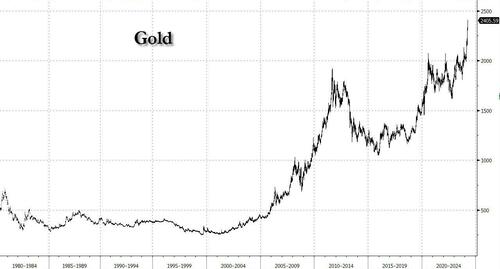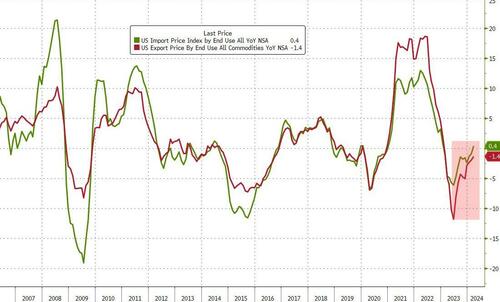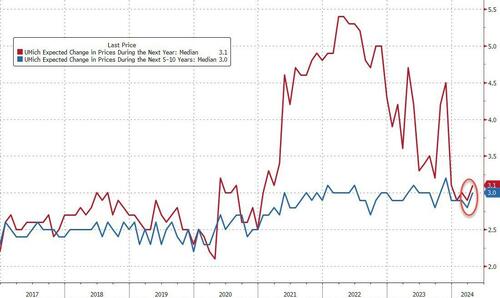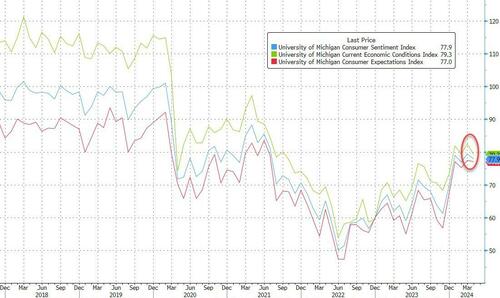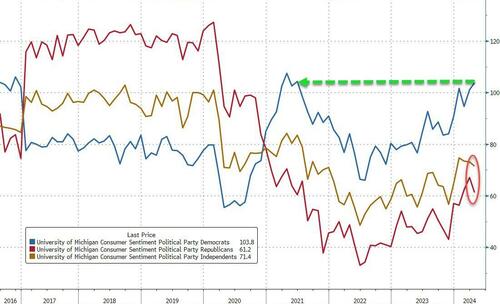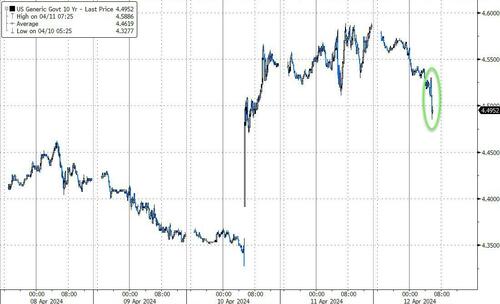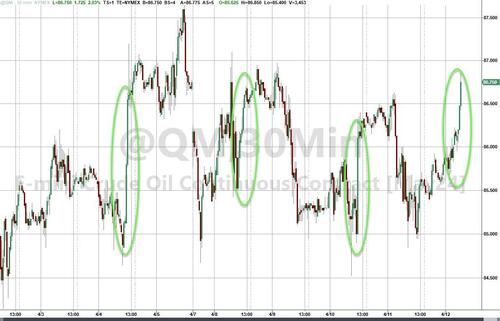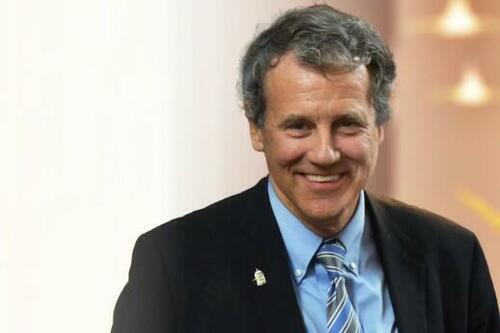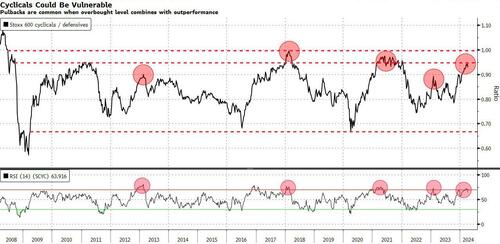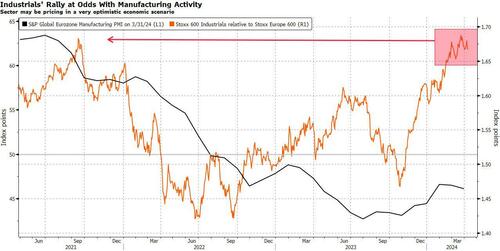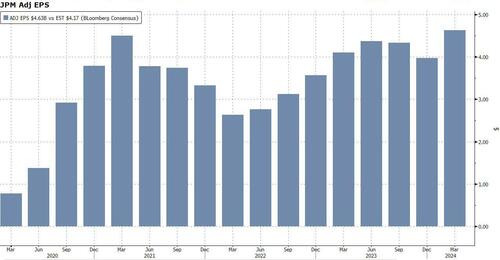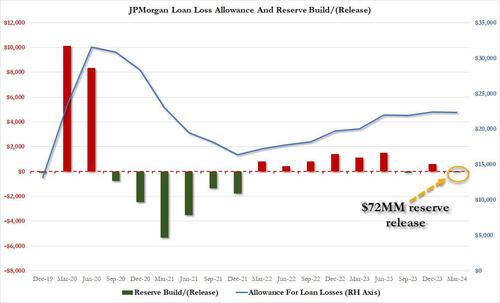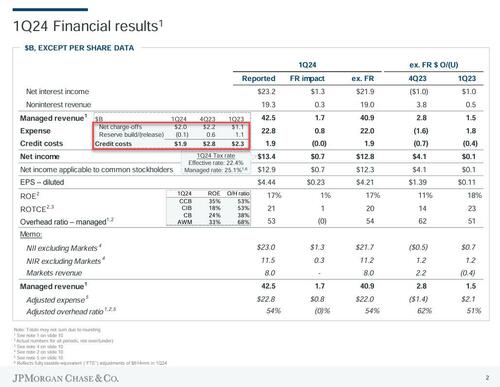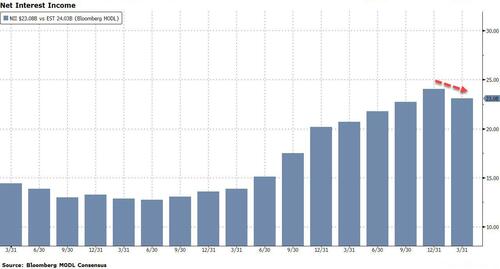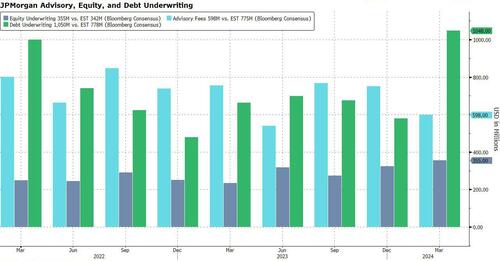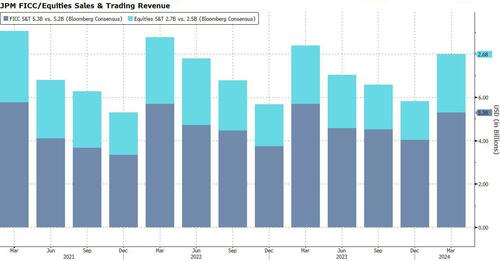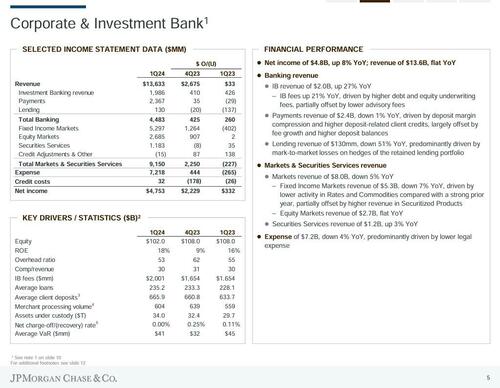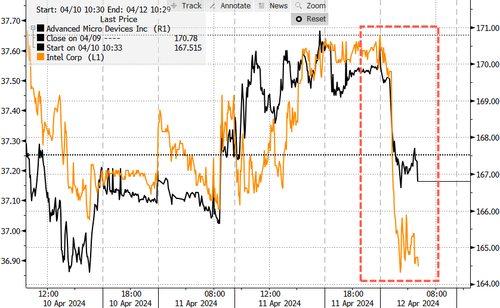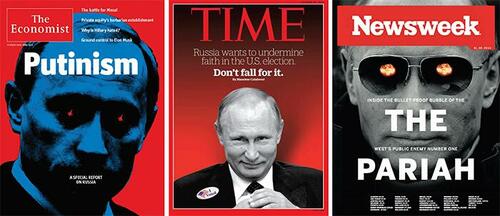It is sad that there are what you might call professional Catholics who make a living on their Catholicism, but in whom the spring of faith flows only faintly, in a few scattered drops. We must really make an effort to change this.
Distinction Matter - Subscribed Feeds
-
Site: LES FEMMES - THE TRUTH
-
Site: Zero HedgeThe Final Nail In The Coffin Of Synchronized Central Bank ActionsTyler Durden Fri, 04/12/2024 - 11:20
By Elwin de Groot, head of macro strategy at Rabobank
And now the end [to monetary tightening] is near … And so I face that final curtain …
My friend I'll say it clear … I'll state my case, of which I'm certain [– Christine Lagarde]
As we head into the weekend and gold prices just reached their highest level ever and the euro has slipped below 1.07 for the first time since November last year (perhaps also as some market participants worry about an imminent attack on Israel by Iran or its proxies), we may conclude that this week has proved to be the final nail in the coffin of synchronized central bank policy actions.
Not so long ago ‘June’ appeared to be the month for the two major global central banks. But in the last few weeks the Fed got it’s ‘itchy fingers’ slapped by stronger-than-expected labor market and sticky (services) CPI data. It is now fairly clear that ‘June’ is no longer the month of truth for the Fed, as our own Philip Marey explained earlier this week in his post Fed-minutes comment – we have moved the goalpost for the Fed to September. The Fed’s Collins said yesterday at an event in New York that recent data had eased concerns about “an imminent need” to adjust interest rates. Well, that’s one way to say it! WSJ’s Nick Timiraos put it more starkly, noting that that “Fed Rate Cuts Are Now a Matter of If, Not When”, which kind of captures the sentiment.
But over to Europe then, where the ECB yesterday gave some strong hints that a June cut is forthcoming. Although persistent price pressures in services remain somewhat of a concern, this doesn’t appear to be in the way of a first cut at the next policy meeting. As we explain here, the Council seems to have made up its mind now that i) the data (in the form of a weak economy and disinflationary forces) have continued to move in the right direction and that ii) a few cuts (let’s start with one) would still keep policy sufficiently restrictive so as to not derail the disinflation process. Despite its mantra of ‘data dependence’ and inflation not having reached its target yet, the Council seems pretty convinced that a cut would be appropriate. “We will not wait for everything to be 2% before we cut”, captures the idea that ECB is now more concerned of falling behind the curve at some point than making an policy error by easing too quickly and sustaining the stickiness services inflation and/or tightness in the labor market. But by emphasizing its data dependence and that it is not pre-committing to any kind of easing trajectory, it probably believes that it can keep the risk of that second scenario materializing at an acceptable level.
But what of course stands out from this development is that the ECB has increasing confidence that it can go its own (European) way. Some observers, including ourselves, note it is a great opportunity for the ECB to demonstrate its ‘independence’, by taking the lead instead of being influenced by what is happening in the US. This shouldn’t be an issue if there is a more fundamental gap opening up between the Eurozone and the US that -indeed- warrants an independent and divergent policy stance. The biggest risk is actually when this perceived gap is not ‘structural’ but sufficiently persistent to push both central banks in different directions when actually that is not really warranted.
A weakening of the Euro on the back of this divergence could of course warrant a slower easing cycle on the part of the ECB at some point. But, to be fair, any model will tell you that you need a pretty significant drop in the euro before this has a material impact on inflation. As a rule of thumb, a 1% drop in EUR/USD – associated with a 0.5% drop in the effective exchange rate – would raise domestic inflation by 0.05% in the first year and 0.15% after three years. Conversely, one could even argue that higher US rates could spill over to Europe dampening the effectiveness of ECB easing and thus warranting even a slightly faster cutting cycle.
But the biggest risk, arguably, is that the ECB simply has it wrong on fundamental grounds. That (global) inflationary forces are more persistent (or will return with a vengeance) and that the recent US inflation data are a harbinger of global trends rather than some statistical aberration. On that note, it is interesting to point out that Ms. Lagarde yesterday clearly did not want to be drawn too much into a comparative analysis between Europe and the US, although she noted that the ‘nature’ of US inflation was different from the perspective of fiscal stimulus and investment (more of both in the US). While that may be true, we would also argue that most of the disinflation so far has come from (global) ‘supply-driven’ factors: lower energy prices, lower tradable goods inflation and (more recently) lower food prices. Not services inflation! And there is obviously a parallel with the US data, albeit, perhaps, on a different level and persistence. So although the ECB is increasingly confident that it can diverge from the Fed – since its domestic data and trends take precedence over global developments – it is actually on the domestic inflation front where that divergence is the least convincing!
Turning briefly to another ‘front’, namely the geopolitical, we also observe a hardening stance from all the parties involved, but in Europe this comes with, well, European characteristics. This week we saw both the release of a 700+ European Commission report on ‘state-induced distortions in China’s economy’, a report that will likely open the door to far more EU trade actions against China, and subsidies to counteract it. This immediately drew a stinging rebuke from China, which “strongly opposes the European Commission’s subjective, one-sided and erroneous assessment of China’s socialist market economy to create an excuse for its discriminatory anti-dumping practices”, the Ministry of Commerce said, according to Xinhua news. A German Kiel Institute report released recently notes that “[…] even according to a very conservative estimate, counting only the more easily quantifiable subsidy instruments, industrial subsidies add up to about Euro 221 bn or 1.73% of Chinese GDP in 2019.” This contrasts with some 0.4-0.7% in most other economies with which it compares China.
That said, we should also mention the recent visit by German Chancellor Scholz to China and now also Italian PM Meloni planning to visit Beijing to strengthen economic/trade ties after ditching Italy’s support for China’s Belt and Road initiative.
Meanwhile, the Commission also published a discussion paper on the economic impact of defense spending, arguably, to stimulate and support the discussion of how to do this in the most effective way. It notes that “[…] the literature on the existence of a causal relationship between defence spending and economic growth is not unanimous. Although favourable impacts are more frequently reported in advanced economies than in less developed ones, the outcomes are dependent on the time horizon and on the methodology used.”
More signs of the hardening stance came via German defense minister Boris Pistorius, who warned yesterday that Europe should prepare for a Russian attack as he compared Russia invasion of Ukraine to Hitler’s annexation of Czechoslovak territory in 1938. Last week Pistorius called for easing Germany’s debt rules.
It’s hard to summarize all this into a single sentence. Is it strategic ambiguity? Perhaps, but it is definitely the European Way…
-
Site: Mises InstituteSimon Guenzl joins Bob to push back on Dave Smith's recent appearance, where Dave had made the case against open borders.
-
Site: Zero Hedge16 GOP Attorneys General Challenge Garland's Comments On Voting LawsTyler Durden Fri, 04/12/2024 - 10:20
Authored by Matt McGregor via The Epoch Times (emphasis ours),
A group of Republican state attorneys general are pushing back against U.S. Attorney General Merrick Garland’s comments made in March at a church in Selma, Alabama, where he discussed using the Department of Justice (DOJ) to interfere in state voting laws.
 Attorney General Merrick Garland testifies before the House Judiciary Committee in Congress in Washington on Sept. 20, 2023. (Madalina Vasiliu/The Epoch Times)
Attorney General Merrick Garland testifies before the House Judiciary Committee in Congress in Washington on Sept. 20, 2023. (Madalina Vasiliu/The Epoch Times)
Indiana Attorney General Todd Rokita, in a letter supported by 15 other GOP prosecutors, including Ken Paxton in Texas and Liz Murrill in Louisiana, stated that Mr. Garland’s comments are “concerning.”
“In your speech, you claimed that democracy is under attack by ‘discriminatory, burdensome, and unnecessary restrictions on access to the ballot,’” Mr. Rokita wrote. “In response to these allegations, you announced that you ‘double[d] the number of lawyers in the civil rights division’ and ‘launched the Justice Department’s Election Threats Task Force,’ signaling your intent to intrude on our states’ authority.”
Mr. Rokita called this a “weaponization of the DOJ” fueled by Mr. Garland’s personal views, which he called a “serious threat to the principles of federalism and separation of powers, but also to democracy and the rule of law.”
In the letter, Mr. Rokita said the U.S. Constitution is clear in its direction to leave state elections up to the elected representatives of those states.
“Any subversion of these clear mandates would be undermining our Constitution and law and order,” he wrote. “And we think your remarks undermine these principles in a few ways.”
Mr. Garland told the audience at the Tabernacle Baptist Church that his DOJ is challenging state laws that he said are placing unneeded restrictions on black voters. He said black voters are disenfranchised by these restrictions on mail-in voting, the use of drop boxes, and voter ID.
“That is why we are working to block the adoption of discriminatory redistricting plans that dilute the vote of Black voters and other voters of color,” Mr. Garland said. “We are holding accountable jurisdictions that fail to provide accessible vote centers for voters with disabilities. We are defending the ability of private individuals—not just the government—to bring lawsuits under the key provisions of the Voting Rights Act and the Civil Rights Act of 1964.”
Voter Fraud: ‘Very Real’
Mr. Rokita addressed Mr. Garland’s statement on voter ID laws, stating that contrary to Mr. Garland’s claiming they are discriminatory, they prohibit voter fraud, which he called “very real,” and referenced several occurrences.
“With these repeated instances of voter fraud, the DOJ should be championing these laws and encouraging enforcement of them,” Mr. Rokita said. “Individuals are required to use an ID to prove identity when driving a car, boarding an airline, buying cigarettes, or purchasing alcohol, and none of these identification requirements are considered ‘discriminatory’ or ‘burdensome.’ Requiring an ID to vote in an election is no different.”
He then called out Mr. Garland’s claim that states imposed “unnecessary restrictions” on mail-in voting and drop boxes.
“Numerous security risks exist with mail-in voting and drop boxes, and these methods of voting have led to the proliferation of election fraud,” he said, citing multiple instances.
He then referenced Mr. Garland’s comment in which he said the Voting Rights Act (VRA) has been weakened by legislation.
“This statement is factually incorrect,” he said. “When the VRA was enacted in 1965, a limited number of jurisdictions required federal oversight over its state election laws to combat discrimination. The original intent of the VRA was to ensure that the rights of Americans were not infringed upon at the ballot box based on their race.”
The law justifiably singled out states that were restricting the right to vote but had always meant to be “temporary legislation.”
“The Voting Rights Act is not under attack,” Mr. Rokita said. “Election security measures passed by state governments do not ‘make voting more difficult,’ nor are they dismantling the right to vote. Instead, common sense election laws strengthen our electoral process to ensure free and fair elections are conducted among the states; especially since voter fraud does exist.”
However, the right to vote is under attack by progressive elected officials, he said, who are allowing illegal aliens to vote in elections.
“In some cases, courts found these laws unconstitutional, and rightly so,” he said.
State attorney generals must defend their laws, he said, most importantly during a time when the Biden administration’s border policy has made them vulnerable to intrusions and violations of sovereignty.
“Finally, as you mention, the Department of Justice is ‘fighting back’ against these commonsense election security measures passed by the states in numerous ways,” he said.
The expansion of federal attorneys in the DOJ’s Voting Section of the Civil Rights Division and the election task force suggests a federal interference that goes against what a constitutional republic is supposed to be about, he wrote.
“The DOJ’s expansion serves as a direct attack on the states’ role in regulating elections,” he said. “Instead of working with the states to secure elections, you suggest weaponizing the DOJ through the civil rights division to undermine anything that you subjectively believe is a ‘threat [to] democracy.’”
Mr. Rokita said Mr. Garland is only concerned with using the DOJ to build up the vote of the Democratic party.
“And by using the justice system in this way, you diminish any democratic principles you claim to defend,” he said.
The Epoch Times contacted the DOJ for comment.
-
Site: Zero HedgeUMich Inflation Expectations Jump Higher At Start Of April, Sentiment Sinks But Democrats HappyTyler Durden Fri, 04/12/2024 - 10:08
CPI is resurgent, PPI's trend is no longer lower, and this morning we saw import and export prices rising (or not falling) at their fastest pace in a year...
Source: Bloomberg
We say all that because this morning, we are told by UMich that in preliminary April data, Americans' expectations for inflation jumped higher...
Source: Bloomberg
“These increases in inflation expectations are modest enough that consumers do not appear worried that high inflation will come roaring back,’’ Joanne Hsu, director of the survey, said in a statement.
However, “while consumers are fully aware that inflation has come down substantially since 2022, they are not satisfied by the current pace of disinflation.”
The headline UMich sentiment index declined, led by a drop in 'current conditions'...
Source: Bloomberg
"Expectations over personal finances, business conditions, and labor markets have all been stable over the last four months," according to UMich.
"However, a slight uptick in inflation expectations in April reflects some frustration that the inflation slowdown may have stalled."
Democrats appear the most confident, with their sentiment pushing to its highest since June 2021. This as both Republicans and Independents saw confidence decline...
Source: Bloomberg
Finally, it appears all those illegal immigrants that are stuffing the payrolls prints are not buying large household durables...
Source: Bloomberg
Overall, UMich notes, that consumers are reserving judgment about the economy in light of the upcoming election, which, in the view of many consumers, could have a substantial impact on the trajectory of the economy.
-
Site: Mises InstituteWhile politicians and bureaucrats always claim to work in the "public interest," the rewards they gain for making bad economic decisions are more important to them than any satisfaction they get from supposedly "serving the people."
-
Site: Steyn OnlineCanada - the first hermaphrodite member of the G7...
-
Site: AsiaNews.itIn a statement, the National United Christian Forum calls on Christians to vote in the upcoming general election (19 April-1 June). Expressing a preference is not only "a symbol" but also a "powerful tool for growth and good governance" to build a 'society that is inclusive and which uplifts all the members.'
-
Site: Zero HedgeHow Taxpayers Will Heavily Subsidize Democrat Boots On The Ground This ElectionTyler Durden Fri, 04/12/2024 - 09:50
Authored by Ben Weingarten via RealClear Wire,
Progressives are using legal loopholes and the power of the federal government to maximize Democrat votes in the 2024 election at taxpayers’ expense, RealClearInvestigations has found.
The methods include voter registration and mobilization campaigns by ostensibly nonpartisan charities that target Democrats using demographic data as proxies, and the Biden administration’s unprecedented demand that every federal agency “consider ways to expand citizens’ opportunities to register to vote and to obtain information about, and participate in, the electoral process.”
A dizzying array of overwhelmingly “democracy-focused” entities with ties to the Democratic Party operating as charities and funded with hundreds of millions of dollars from major liberal “dark money” vehicles are engaged in a sprawling campaign to register the voters, deliver them the ballots, and figuratively and sometimes literally harvest the votes necessary to defeat Donald Trump.
These efforts, now buttressed by the federal government, amplify and extend what Time magazine described as a “well-funded cabal of powerful people ranging across industries and ideologies,” who had worked behind the scenes in 2020 “to influence perceptions, change rules and laws, steer media coverage and control the flow of information” to defeat Trump and other Republicans. The “shadow campaigners,” Time declared, “were not rigging the election; they were fortifying it.”
Heading into 2024, “there is not a ‘shadow’ campaign,” said Mike Howell, executive director of the Heritage Foundation’s Oversight Project. “There is an overt assault on President Trump and those who wish to vote for him occurring at every level of government and with the support of all major institutions.”
By contrast, Republican Party stalwarts lament that no comparable effort exists on their side. The GOP’s turnout and messaging efforts seek to thread a difficult needle by encouraging early and absentee voting and ballot-harvesting – pandemic-era measures that Trump and supporters blame for his 2020 electoral defeat – while the party simultaneously fights the mainly blue-state laws that made the practices possible. The party’s position is further complicated by its standard-bearer’s warnings of a rigged election bigger than in 2020, which some speculate could turn off moderate swing voters.
Electioneering 'Super-Weapons'
The IRS permits tax-exempt nonprofit groups to engage in voter registration and get-out-the-vote drives so long as they do not “refer to any candidate or political party” nor conduct their activities “in a biased manner that favors (or opposes) one or more candidates prohibited.”
These entities have become magnets for funds not only from wealthy donors, who can contribute without traditional campaign finance limits – and get a tax break to boot – but also abundantly endowed private foundations that are prohibited from engaging in partisan activities.
In recent years, dozens of progressive-oriented 501(c)(3)s, now pulling in upwards of $500 million annually, have engaged in purportedly neutral efforts to impact elections, according to Hayden Ludwig, director of Policy Research at the election integrity-focused advocacy group, Restoration of America.
In practice, critics like Ludwig argue, left-leaning charities flout the law by registering and mobilizing demographics that tend to vote disproportionately Democratic behind a veil of non-partisan democracy promotion.
During the 2020 election, for example, the Voter Participation Center solicited millions of ballot applications in swing states – many of them prefilled for respondents. This nonprofit, like its peers, is clear that it isn’t targeting just any voters, but what it and progressive activists have dubbed a “New American Majority” of “young people, people of color and unmarried women.”
Tom Lopach, a longtime Democratic Party operative and the center’s president and CEO, told RCI in a statement: “We do the work that state election officials typically do not do – seeking out underrepresented voting-eligible Americans Tom Lopach … This is difficult but necessary work that brings democracy to eligible Americans’ doorsteps.”
In 2020, Facebook founder Mark Zuckerberg and his wife Priscilla Chan showed how supposedly neutral efforts can have a partisan impact when they funneled some $400 million through two progressive-led but purportedly nonpartisan nonprofits into election offices across the country.
That money disproportionately went to jurisdictions that Joe Biden won in the pivotal battleground states that delivered his victory, often flowing to left-leaning nonprofits to whom election offices outsourced the administration of sometimes critical functions.
In April 2022, a primary conduit of these so-called “Zuckerbucks,” the Center for Tech and Civic Life, announced the launch of a successor to the 2020 effort – the U.S. Alliance for Election Excellence, a five-year $80 million program “to envision, support, and celebrate excellence in U.S. election administration.”
“The left has assembled an impressive ‘election-industrial’ complex of non-profit organizations that is constantly working towards goals like ‘promoting participation’ targeting ‘underrepresented minorities,’” said Jason Snead, executive director of the conservative Honest Elections Project. Such terms, Snead says, “are code for identifying and mobilizing liberal voters.”
Election experts view such activities as potentially decisive.
“‘Nonpartisan’ and ‘charitable’ voter registration and get-out-the-vote groups” are the Democratic Party’s “electioneering super-weapon[s],” said Parker Thayer, an analyst with the conservative-oriented Capital Research Center in Washington, D.C.
'Everybody Votes' – But for Whom?
Of these, Thayer sees the Everybody Votes Campaign as of paramount importance.
Born of a plan “commissioned by [Hillary] Clinton campaign chairman John Podesta, funded by the Democratic Party’s biggest donors, and coordinated with cut-throat Democratic consultants,” Thayer writes in an extensive analysis of the group’s efforts, “the Everybody Votes campaign [has] used the guise of civic-minded charity to selectively register millions of ‘non-white’ swing-state voters in the hopes of getting out the Democratic vote.”
It does so by funding and training over 50 community groups to register voters to close “the voter registration gap in communities of color,” which it attributes to “modern forms of Jim Crow laws,” such as voter ID requirements, the group’s executive director, Nellie Sires, said in a January 2024 interview.
From 2016-2021, the Everybody Votes Campaign, doing business as three entities, collected over $190 million from major Democratic Party donors, unions, and environmental activists. Some of the largest donors include the League of Conservation Voters Education Fund; the New Venture and Hopewell Funds, managed by for-profit consulting firm Arabella Advisors; and the George Soros-funded Foundation to Promote Open Society – all 501(c)(3) public charities or private foundations forbidden from supporting “voter education or registration activities with evidence of bias.”
The Everybody Votes Campaign distributed the funds to a slew of left-leaning state-based voter registration organizations largely in eight pivotal states from 2016 to 2019 – Arizona, Colorado, Florida, Georgia, Ohio, North Carolina, Virginia, and Nevada – and then to Pennsylvania, Michigan, and Wisconsin in 2021.
According to Thayer’s analysis, the Everybody Votes Campaign’s voter registration push “would have provided Democrats more votes than the total margins of victory in Arizona, Georgia, Nevada, and Pennsylvania,” securing Joe Biden’s victory in the 2020 election.
'4 to 10 Times More Cost-Effective'
One notable backer of the Everybody Votes Campaign is Mind the Gap, a “Moneyball-style” Silicon Valley Democratic Super PAC founded by Stanford law professor Barbara Fried, and connected to the political activities of her convicted crypto-fraudster son, Sam Bankman-Fried.
The analytics-focused outfit prepared a confidential strategy memo leaked in advance of the 2020 election, noting that “501(c)(3) voter registration focused on underrepresented groups in the electorate” would be the “single most effective tactic for ensuring Democratic victories” – “4 to 10 times more cost-effective” on after-tax basis at “garnering additional Democratic votes” relative to alternatives like “broadcast media and digital buys.”
Mind the Gap recommended that donors contribute to three organizations: the Voter Participation Center and its sister organization, the Center for Voter Information for mail-based registration efforts, and Everybody Votes for site-based registration efforts.
The largest grant recipient, receiving $24 million during the 2016-21 period, was State Voices, which describes itself as a “nonpartisan network of 25 state-based coalitions … that collectively partner with over 1,200 organizations” consisting of “advocates, organizers, and activists … work[ing] together to fight for a healthy democracy and political power for Black, Indigenous, Latinx, Asian American and Pacific Islander (AAPI), and all people of color (BIPOC).”
Another top recipient, raking in over $10 million, was the Voter Participation Center.
According to the Capital Research Center, the Everybody Votes Campaign would collect and spend over $50 million in connection with the 2022 midterm elections – the most recent period for which financials are available. All told, since its founding in 2015, the Campaign says, its network has registered 5.1 million voters, of whom 76% are people of color; 56% are women; and 47% are under the age of 35.
Last November, the news outlet Puck reported on a secret memo circulated by Mind the Gap regarding its plans for 2024. “Our strategy early in the 2024 presidential race will be to massively scale high-performing voter registration and mobilization programs,” the memo read. The PAC again specifically directed donors to the Everybody Votes Campaign, which did not respond to requests for comment.
Lopach, who has worked in Democratic Party politics his entire career, bristled at RCI’s questions regarding critics’ claims of a partisan bent to its work. “The presumptions baked into the questions … emailed to us are inaccurate and reveal the reporter’s own biases,” he responded, while emphasizing the organization’s targeting of “underrepresented voting-eligible Americans.”
Thayer has dubbed Everybody Votes the “largest and most corrupt ‘charitable’ voter registration drive in American history.”
Of such organizations’ claims of nonpartisanship, Howell told RCI: “If they were truly interested in an informed participatory constitutional Republic, they would have an even-handed approach to registering voters.”
“Call me when they show up to a NASCAR race, Daughters of the American Revolution event, or a gun show,” Howell added. “Then we can pretend for a minute that these are beyond just facial efforts to appear somewhat neutral.”
Challenges for GOP
But NASCAR races have not been hubs for GOP-led voter registration efforts either. Restoration of America’s Ludwig estimates that the right may spend as little as 1% of what the left spends on voter registration efforts.
A recent memo from the Sentinel Action Fund, a super PAC that aims to elect conservatives, noted that in the 2022 election cycle, while $8.9 billion was spent on federal elections, there were zero large independent expenditure organizations on the right focused on get-out-the-vote efforts or “ballot chasing.”
Republican Party vehicles and conservative outfits like grassroots-oriented Turning Point Action, a 501(c)(4), are engaged in such efforts in the 2024 cycle, but the scale and sophistication of their political counterparts’ efforts would appear unrivaled at this point.
Election experts attribute this gap to several factors beyond the GOP’s focus on other tactics to win elections, or ineffectiveness. They note that Democratic voters tend to be more concentrated in urban areas and college campuses, making it easier to run efficient registration drives. As regards early and absentee voting and ballot harvesting, it is not clear if these efforts will substantially grow the pool of Republican voters versus merely enabling the party to “bank” votes earlier.
With respect to the use of 501(c)(3)s to conduct such activities, Ludwig said some conservatives may still be fearful of running afoul of the IRS – through exploiting tax laws to pursue efforts perceived to be partisan effectively on the taxpayers’ dime – in the wake of its targeting of Tea Party groups for extreme scrutiny during the Obama years.
‘Bidenbucks’: ‘Zuckerbucks’ on Steroids
Since the 2020 election, Democrats have opened a second apparent electioneering front that Republicans could not match even if they wanted to: The rise of so-called “Bidenbucks,” which uses the “unlimited funding, resources, and reach” of the federal government and agency offices located nationwide,” to turn out favored voters, according to Stewart Whitson, legal director of the conservative Foundation for Government Accountability.
In March 2021, President Biden introduced Executive Order 14019. The directive on “promoting access to voting” orders every federal agency, more than 600 in all, to register and mobilize voters – particularly “people of color” and others the White House says face “challenges to exercise their fundamental right to vote.” It further directs the agencies to collaborate with ostensibly nonpartisan nonprofits in pursuit of its goals.
As RCI has previously reported, EO 14019 appears to have been designed by left-leaning think tank Demos and implemented in consultation and sometimes coordination with a slew of progressive, labor, and identity-focused groups with the goal of generating up to 3.5 million new or updated voter registrations annually.
The ACLU and Demos have reportedly helped execute the order. RCI additionally found that at least two recipients of grants under the Everybody Votes Campaign, the NAACP and UnidosUS – formerly the National Council of Raza – were also listed on an email as participants in a July 2021 listening session on the executive order convened by the White House and agency officials.
Whitson, whose organization unearthed that email in its fight to expose details about the order, emphasized that “[U]nlike 2020 wherein the shadow campaign was conducted by private citizens seeking to influence government election operations from the outside, the threat we face in 2024 is being launched from within the government itself.”
Facing both congressional scrutiny and litigation, the administration has closely guarded the strategic plans agencies were to develop to carry out the order, how they are implementing them, to what end, and with whom.
Perfunctory press releases, reports from groups supportive of the order, and documents slowly ferreted out via FOIA requests and litigation, however, demonstrate that relevant agencies have sought to drive voter registration via public housing authorities, child nutrition programs, and voluntary tax preparation clinics.
In August 2023, U.S. Citizenship and Immigration Services issued updated guidance calling for the agency to register voters at naturalization ceremonies.
More recently, the Department of Education did the same, blessing the use of federal work-study funds to pay students for “supporting broad-based get-out-the-vote activities, voter registration,” and other activities. Scott Walter, president of the Capital Research Center, recently told the Epoch Times that the Department had previously threatened schools “that you better be registering students or you could lose your federal funds.”
When asked by RCI to respond to Walter’s claim, the Department of Education would not. Over two dozen Pennsylvania state legislators challenged the order via a lawsuit in January. Citing alleged unlawful attempts by several agencies to register Keystone state voters, the lawmakers asserted:
"By engaging in a targeted voter registration effort of this magnitude, focused specifically on these agencies and the groups of potential voters they interact with, leveraging the resources and reach of the federal government, this effort appears to be a taxpayer-funded get-out-the-vote effort designed to benefit the current President’s political party."
Echoing this view, Whitson’s Foundation for Government Accountability submitted an amicus brief noting that “all of the federal agencies FGA has identified as taking active steps to carry out EO 14019 have one thing in common: They provide government welfare benefits and other services to groups of voters the vast majority of which have historically voted Democrat.”
The plaintiffs alleged the executive order violated both Pennsylvania law limiting voter registration efforts to non-federal actors, and constitutional provisions reserving election laws to the states. On March 26, a district court dismissed the case, claiming the plaintiffs lacked standing. Whitson told RCI that others would likely lodge similar lawsuits, building on the Pennsylvania legislators’ case in the wake of the dismissal. Days later, The Federalist reported that the plaintiffs intended to appeal their case to the U.S. Supreme Court. A White House spokesperson did not reply to RCI’s inquiries regarding the executive order.
Opposition and Circumvention
Republicans have had more success opposing the use of Zuckerbucks and other private monies used to finance public elections. More than two dozen states would move to ban or restrict such grants in response to the activities observed during the 2020 election.
Most recently, Wisconsin, where some of the most controversial Zuckerbucks-related efforts took place, was added to that list when, on April 2, voters approved a constitutional amendment barring the private funding of elections.
Despite this crackdown and the feds seemingly stepping into the breach, efforts to privately finance election administration persist. The U.S. Alliance for Election Excellence bills itself as an initiative to bolster “woefully unsupported” election offices to “revitalize American democracy.”
The organization says it services jurisdictions – 11 listed on its website, ranging across states from Arizona to California and Wisconsin – with “training, mentorship, and resources.” Alliance officials did not respond to RCI’s inquiry about whether it would be terminating the relationship with the city of Madison, Wisconsin., in light of the passage of the recent ballot measure that would seem to have barred it. Nor did it respond to RCI’s other inquiries in connection with this article.
Most of these partnerships were initiated with jurisdictions in states that have not banned Zuckerbucks, though it has sought to circumvent such prohibitions in Georgia and Utah. The stated goal of the Alliance for Election Excellence is to support voters via measures like assisting participating centers in “redesigning” forms to make them more intuitive and purchasing infrastructure “to improve election security and accessibility.”
Alliance launch partners include entities such as:
- The Center for Civic Design, which works with election offices “using research, design, accessibility, and plain language to remove barriers in the voter journey and invite participation in democracy;”
- The Elections Group, to “implement new programs or improve processes for voters and stakeholders”; and
- The Center for Secure and Modern Elections to “modernize the voting system, making elections more efficient and secure.”
Critics argue this seemingly more modest effort is, in reality, an ambitious Zuckerbucks rebrand.
Snead’s Honest Elections Project published a report in April 2023, based in part on documents received from FOIA requests, indicating “that the Alliance is a reinvention of CTCL’s scheme to use private funding to strongarm election policy nationwide.”
Among other takeaways, it found that:
- The Alliance offers services that touch every aspect of election administration, ranging from “legal” and “political” consultation to public relations, guidance, and assistance with recruitment and training.
- The Alliance is gathering detailed information on the inner workings of participating election offices and developing “improvement plans” to reshape the way they operate.
The report shows that many of the alliance’s launch partners, starting with the Center for Tech and Civic Life and the Center for Civic Design, are funded by major Democrat-tied, so-called “dark money” groups such as the Democracy Fund and Arabella Advisors’ New Venture Fund and Hopewell Fund.
The Democracy Fund is led by Democrat tech billionaire Pierre Omidyar, which has granted some $275 million to like-minded organizations from publications like Mother Jones and ProPublica to the Voter Registration Project since its founding.
The District of Columbia recently closed a criminal investigation into Arabella, whose fund network reportedly spent nearly $1.2 billion in 2020 alone, after probing it over allegations its funds were pursuing political ends in violation of their tax-exempt statuses. The Center for Secure and Modern Elections, the Honest Elections Project says, pushes “left-wing priorities like automatic voter registration” and is run by the New Venture Fund. The Elections Group’s CEO and co-founder, Jennifer Morrell, previously served as a consultant at the Democracy Fund.
The Capital Research Center’s Walter uses a football analogy to explain why he sees these efforts as untoward. He told RCI:
"Election offices are the refs in elections; the parties are teams trying to score. You’d be puzzled if you heard Super Bowl refs say they’re trying to boost points scored. You’d be outraged if you learned those refs had received money and training from people who previously worked for one team’s offensive coaching staff. That’s what left-wing political operatives, using left-wing money, are doing, and it’s clearly unfair."
Non-Trump Lawfare
Democrat-aligned groups continue to engage in litigation, like that brought by chief election lawyer Marc Elias, aimed at loosening election laws to their benefit. Snead told RCI, “There are more than 70 active lawsuits right now targeting voter ID laws, anti-ballot harvesting laws, signature verification, drop box regulations, and more.”
After securing victory in a lawsuit requiring signature verification for mail voting in Pennsylvania, the RNC touted its engagement as well in 81 election integrity cases this cycle. Swing-state Wisconsin is another major battleground for such efforts.
There, Elias’ legal team has challenged witness signature requirements and bans on election clerks filling address information on mail-in ballots. It and others are also working to overturn a state Supreme Court decision finding drop boxes illegal. The Badger State’s now liberal-majority Supreme Court announced in March it would take up the case.
Cutting against these efforts are not only the state’s citizen-approved Zuckerbucks ban, but another Badger-passed April 2 ballot measure amending the state’s constitution to prohibit those other than “an election official designated by law” from carrying out election-related tasks.
Watchdogs like Howell are concerned that left-leaning electioneers and lawfare forces collectively are pursuing an “election ‘dis-integrity’ strategy … to greatly expand the universe of ballots while limiting any ability to ensure that they are fairly cast and counted.”
“It’s a basic recipe for fraud.”
Elias says those seeking to combat such efforts are engaged in “voter suppression and election subversion.”
Democrats also have the federal government working on their side on the litigation front – and in ways extending beyond the veritable lawfare barrage the Biden Justice Department has leveled at Donald Trump.
Speaking in Selma, Ala., on the 59th anniversary of Bloody Sunday, the 1965 police assault on civil rights marchers, Attorney General Merrick Garland declared that “the right to vote is still under attack.”
Garland vowed the Department of Justice was punching back, including “challenging efforts by states and jurisdictions to implement discriminatory, burdensome, and unnecessary restrictions on access to the ballot, including those related to mail-in voting, the use of drop boxes, and voter ID requirements.”
-
Site: The Orthosphere
“The happiness of others, therefore, has a depressing effect, their unhappiness an elevating effect upon our self-esteem.”
Friedrich Paulsen, A System of Ethics (1899)
Commenter Club Schadenfreude objects to Kristor addressing him as Club Schadenfreude, but his objection is not my concern here. I am, rather, concerned with the meaning of schadenfreude, and perhaps with the significance of operating a club by that name.
Schadenfreude is, of course, a German word that denotes the pleasure a man takes in another man’s misfortune. Not in the misfortune of an enemy, I hasten to add, for that is mere malice. Schadenfreude is the pleasure he takes in the misfortune of a stranger, and perhaps more particularly the pleasure he takes in the misfortune of a friend. Schadenfreude is, in other words, a perversion of compassion, and it is a pleasure with which very few of us are altogether unacquainted.
Ethicists generally recognize schadenfreude as the twin of envy, envy being unhappiness occasioned by another’s happiness, schadenfreude happiness occasioned by another’s unhappiness.
“These are well-known phenomena: they are never entirely wanting in man. The pessimistic philosophers love to dwell upon this truly partie honteuse of human nature.”*
The French phrase means “shameful part,” and like the shameful parts of the human anatomy, envy and schadenfreude are sentiments we take care to conceal. We take care to conceal them because they are dishonorable sentiments, envy entailing an admission of weakness, schadenfreude being pity without the mask.
We see that pity is not all it is cracked up to be when we reflect that pity is much more agreeable to give than to receive. The reason for this is not hard to discover. When I express pity for my friend’s misfortune, I am secretly gratified by the reflection that my circumstances are, by comparison, quite comfortable. When I pity a friend, I am in fact praising myself.
This relation is reversed in envy because, when I praise a friend, I implicitly confess that I am, by comparison, pitiful. Envy is thus wounded self-esteem. Schadenfreude on the other hand is self-esteem petted, stroked, and exquisitely gratified. It is, as I just said, pity without the mask. As Lucretius says in his great atheist poem On the Nature of Things (c. 75 B.C.).
“’Tis sweet, when down the mighty main, the winds
Roll up its waste of waters, from the land
To watch another’s laboring anguish far,
Not that we joyously delight that man
Should be thus smitten, but because ’tis sweet
To mark what evils we ourselves be spared.”**Schadenfreude is not, as is sometimes said, malicious pleasure. It is the pleasure of marking, by observation or report, the suffering of evils from which I have myself been spared. As Lucretius goes on to say:
“ ’Tis sweet, again, to view the mighty strife
Of armies embattled yonder o’er the plains,
Ourselves no sharers in the peril . . .”**Schadenfreude is, to wrap this up, a psychological trick with which my ego assures me I am special. I am (naturally but dishonorably) gratified by the misfortunes of strangers and friends, not because I hate those strangers and friend so bitterly, but because I love myself so tenderly. It is owing to self-love, as my epigraph puts it, that news of their good fortune has “a depressing effect” on my self-esteem, whereas my self-esteem is by reports of their misery most decidedly elevated.
This may be evidence, I cannot forebear to mention, of Adam’s sin.
*) Friedrich Paulsen, A System of Ethics, Frank Thilly ed., Fourth ed. (New York: Charles Scribner, 1899), p. 593.
**) Book 2, William Ellery Leonard trans. -
Site: Zero HedgeCentral Banks Are Buying The Gold TopTyler Durden Fri, 04/12/2024 - 09:15
In investing, “Buy low, sell high” is among the most well-known sayings, and generally, it’s good advice. But with gold still holding near its historic all-time highs, central banks led by China are bucking the classic adage and smash-buying more, buying the top to fortify themselves against a global monetary and financial blow-up.
Last month marked the 17th in a row that the People’s Bank of China (PBOC) continued stacking gold. Notably, the bank typically reports lower numbers than its actual buying volume and is now also introducing a digital yuan to facilitate cross-border gold settlements.
The People's Bank of China announced its gold reserve data for March, with an additional 160,000 ounces of gold reserves added, bringing the total reserves to 72.74 million ounces. pic.twitter.com/Ngalymi8nd
— Bai, Xiaojun (@oriental_ghost) April 8, 2024Russia is also doubling its reserves of gold and foreign currencies on its de-dollarization path, further detaching Russia from the petrodollar empire as it reacts to wartime sanctions from the US and EU. There are other blips on the de-dollarization map as well: though much smaller than Russia and China, Zimbabwe has a new gold-backed currency that lets them dump the USD for trade with China and other countries.
Chinese citizens are trying to divest as well, but from their economy — Chinese buying has become so blistering that gold ETFs have gone haywire, with China repeatedly halting trading as ETFs rocket upward at a gobsmackingly-high premium against physical bullion. It has become increasingly difficult for the Chinese to invest outside of China, due to attempts by the regime to keep investments within the country. Citizens are trying to make moves to protect themselves against their perceptions of domestic economic uncertainty.
Meanwhile, expectations that the Fed and other Western central banks will be cutting rates this year amidst continuing wars in Ukraine and the Middle East provide further rocket fuel for the gold price, with central bank buying helping it hold its new levels despite whatever else seems to be going on in global markets.
A Year of Central Bank Buying: Gold vs USD April 2023 – April 2024
Source: Bloomberg
While shorter-term corrections are always to be expected, the macro factors support the view that, despite its awe-inspiring path upward in the past few months, the rally for gold hasn’t finished. While inflation isn’t contained, the Fed is expected to stay the course with planned 2024 rate cuts that will make dollar weakness even worse. This can only mean higher prices for gold against USD.
Reacting to warnings from Bloomerberg about ballooning debt and the powder keg of inflationary pressure, Peter Schiff said:
“We have a much bigger problem than they acknowledge — that’s why the price of gold is at a record high, that’s why it’s going to keep going up.”
With the overstretched and over-indebted American empire increasingly in a state of potentially terminal decline, BRICS countries are stacking hard assets with the hopes of overtaking the West as the next economic superpowers in the coming decades. While they have fiat currencies of their own, none have anything resembling the world reserve currency status enjoyed by the USD. Buying the top even as gold continues upward tells a story of their future visions of US dollar chaos.
Besides, if you expect the dollar to fail, as dominant fiat currencies historically have, then “the top” doesn’t matter — if the bottom for fiat is zero, then there’s no meaningful top for hard assets like gold in fiat terms. And just as you didn’t want to be the last schmo holding seashells when no sane person would give you even the tiniest sliver of gold in exchange, it’s wise of central banks to avoid being the last ones trying to trade worthless paper for gold that, when fiat is functionally dead, will be infinitely more valuable.
Because when you zoom out far enough, the exchange price of fiat currencies always reverts to its true value of zero.
-
Site: Zero HedgeFutures Tumble On Disappointing JPM Earnings, Surging Geopolitical RisksTyler Durden Fri, 04/12/2024 - 09:01
Futures are tumbling this morning, hit by disappointing earnings and outllook from the largest US bank, JPMorgan whose stock is down around 3% in a soggy launch to Q1 earnings season, while growing fears of an imminent conflict between Israel and Iran have sent oil surging and futures sliding. As of 8:45am, S&P futures are down 0.7%, at session lows with Nasdaq also dumping after reports China has asked its telecom carriers to start phasing out foreign chips. The drop comes as we see safe having flows move capital into TSYs with bond yields sliding up to 10bps this morning. That said, the USD is higher again with the euro and cable sliding sharply. Commodities are mixed: oil and gold rally amid Middle East tension; base metals are lower amid lower-than-expected China exports (-7.5% vs. -1.9% survey vs. 5.6% prior), while the gold explosion documented last night continues, with gold futures trading just above $2,400 and spot trading just below. Today, the main focus will be banks earnings (C, JPM, WFC). We will also receive Univ. of Mich. Sentiment data.
Bonds are bid also, 10Y -9bps...
In premarket trading, MegaCap tech are mostly lower: GOOG -45bp, TSLA -1.1%, while semis are lower amid headlines on China cutting American chip makers out of its telecoms systems (AMD -1.8%, INTC -1.7%, MU -94bp). Here are the most notable European movers:
- Applied Digital shares drop 11% after the data-center developer reported third-quarter adjusted diluted loss per share that was more than analysts had expected. The company also missed on revenue.
- Corteva shares slip 1.4% after a downgrade to neutral at JPMorgan, which says the agricultural products firm “has its work cut out” for it to reach its earnings guidance for 2024 amid falling crop chemicals prices.
- Coupang shares rise 4.4% after the e-commerce company said it would raise its monthly fee for “Wow” membership for new clients by 58%, starting on Saturday, according to emailed statement.
- DocuSign (DOCU US) shares gain 0.6% as UBS lifts its rating on the e-signature company to neutral from sell, with the stock now approaching fair value.
- Gitlab (GTLB US) shares climb after an upgrade to outperform at Raymond James, which sees the application software company ultimately exceeding $750 million in revenue for fiscal year 2025.
- Globe Life (GL US) shares are up 12%. The life insurance company said it intends to explore “all means of legal recourse against the parties responsible” after a short-seller report from Fuzzy Panda Research.
- Intel and AMD shares fall after the Wall Street Journal reported that China has asked its telecom carriers to start phasing out foreign chips.
The biggest highlight in premarket trading, however, was JPMorgan which dropped as much as 4.4% in premarket after its outlook for full-year net interest income missed expectations. Citigroup Inc. gained after its first-quarter profit topped estimates. Contracts for the S&P 500 fell 0.4%, while those on the Nasdaq 100 slid 0.5% after tech stocks jumped 1.7% Thursday. BlackRock rose in premarket after the world’s largest money manager reported a record $10.5 trillion in client assets. Wells Fargo shares retraced a slump after a miss on NII in its first-quarter report. State Street Corp. gained after its earnings beat estimates.
Separately, attention is also focused on the growing conflict between Iran and Israel where moments ago we got the following flashing red headline which hammered futures to session lows:
- *ISRAEL BRACING FOR POTENTIAL DIRECT ATTACK FROM IRAN IN DAYS
While there is nothing new there, we have heard that several times in the past few days, today the market is extra sensitive and it is sending oil surging, with WTI above $86 and Brent well into the $90.
European stocks were on course for their best day this month, with mining and energy shares leading gains amid a rally in oil and metals, however the gains have fizzled as geopol concerns emerge. The Stoxx 600 is up 0.6% after rising 1% earlier.
Earlier in the session, Asian equities slipped Friday with Hong Kong and South Korea leading the losses, as the region lacks positive momentum following a recent rebound. The MSCI Asia Pacific Index dropped as much as 0.2% in its third straight day of declines, the longest falling streak since early February. Chinese technology stocks including Alibaba and Tencent, as well as South Korea’s Samsung Electronics, were among the biggest contributors to the drop.Hong Kong markets underperformed, with the Hang Seng China Enterprises Index retreating after entering a so-called technical bull market earlier this week. Sentiment has turned cautious after Chinese price data released Thursday underscored deflationary pressures, putting a dampener on budding optimism that the economy is recovering.
In FX, the Bloomberg Dollar Index rises 0.4% while the euro sank to the weakest level against the dollar in five months as prospects grow that the European Central Bank will start cutting rates in June, well before the Federal Reserve can begin easing because of stubborn US inflation. Markets are pricing three rate cuts in the euro zone this year and fewer than two by the Fed. The Swedish krona is the worst performer among the G-10 currencies, falling 0.8% versus the greenback after CPI rose less than expected in March.
Treasuries rise after a steep two-day fall, with US 10-year yields dropping 8bps to 4.50% after surging 22 basis points in the previous two sessions. Data Thursday showed US producer prices in March increased less than forecast, sparking relief after consumer-price growth exceeded forecasts the previous day. German 10-year yields fall 9bps after ECB’s Stournaras said it is time for the ECB to diverge from the Fed. The 10-year Treasury yield dropped seven basis points. Strategists at Bank of America Corp. said a rare rally in both tech stocks and commodities, combined with a jump in bond yields, has echoes of periods when bubbles are forming. The unusual price moves are consistent with bets that interest rates will stay higher for longer while economic growth remains strong — a so-called no-landing scenario.
While that narrative is “correctly in vogue,” there’s also a risk of higher inflation and an increased cost of capital, the strategists led by Michael Hartnett wrote. The price action is “typical of bubbly markets,” according to Hartnett, who makes a comparison with the pre-tech bubble period of 1999.
In commodities, WTI rises 2% to trade near $87 a barrel; spot gold rises 0.9% having earlier topped $2,400/oz for the first time while copper rises 2.3% to the highest since June 2022. Iron ore headed for its best week in two years on speculation that China’s economy may be on the mend, buoying the outlook for demand. A rally in industrial metals strengthened, with zinc rising to a one-year high on increased risks to supply.
To the day ahead now, and the Bank of England will release the Bernanke review on forecasting. Central bank speakers include the BoE’s Greene, the ECB’s Elderson, and the Fed’s Collins, Schmid, Bostic and Daly. Data releases include the UK GDP reading for February, and in the US there’s the University of Michigan’s preliminary consumer sentiment index for April. Finally, earnings releases include JPMorgan, Citigroup, Wells Fargo and BlackRock.
Market Snapshot
- S&P 500 futures down 0.7% at 5,207
- STOXX Europe 600 up 1.2% to 510.39
- MXAP down 0.5% to 175.54
- MXAPJ down 1.0% to 536.11
- Nikkei up 0.2% to 39,523.55
- Topix up 0.5% to 2,759.64
- Hang Seng Index down 2.2% to 16,721.69
- Shanghai Composite down 0.5% to 3,019.47
- Sensex down 0.9% to 74,399.41
- Australia S&P/ASX 200 down 0.3% to 7,788.08
- Kospi down 0.9% to 2,681.82
- Brent Futures up 1.2% to $91.36/bbl
- Gold spot up 1.0% to $2,396.87
- US Dollar Index up 0.35% to 105.65
- German 10Y yield little changed at 2.38%
- Euro down 0.4% to $1.0678
Top Overnight News
- China posts weak trade numbers for Mar, with exports slumping 7.5% Y/Y (vs. the Street -1.9%) while imports dip 1.9% (vs. the Street +1%). RTRS
- China’s push to replace foreign technology is now focused on cutting American chip makers out of the country’s telecoms systems. Officials earlier this year directed the nation’s largest telecom carriers to phase out foreign processors that are core to their networks by 2027, a move that would hit American chip giants Intel and Advanced Micro Devices. WSJ
- Japan’s finance minister reiterated his readiness to act on excessive FX moves as the yen held near a 34-year low. Intervention will probably happen outside Tokyo trading hours to weed out overseas speculators. BBG
- Israel is preparing for a direct attack from Iran on southern or northern Israel as soon as Friday or Saturday, according to a person familiar with the matter. A person briefed by the Iranian leadership, however, said that while plans to attack are being discussed, no final decision has been made. WSJ
- The IEA trimmed its forecast for 2024 oil demand growth on Friday, citing lower than expected consumption in OECD countries and a slump in factory activity. The Paris-based energy watchdog lowered its growth outlook for this year by 130,000 barrels per day (bpd) to 1.2 million bpd, adding that the release of pent-up demand by top oil importer China after easing COVID-19 curbs had run its course. RTRS
- The US has proposed raising tens of billions of euros in debt for Ukraine secured against the future profits generated by Russian state assets that have been frozen by western countries. The G7 group of nations has been split on what to do with €260bn worth of Russian assets put on hold by the west since Moscow launched its full-scale invasion of Ukraine in February 2022. FT
- Big bank earnings kick off with net interest income in focus as fewer rate cuts are expected. JPMorgan is attracting most speculation over whether it will raise NII guidance — which analysts argue is conservative at $90 billion. Adjustments for Wells Fargo and Citi will also be scrutinized. BBG
- Roaring equity markets and the popularity of a new spot bitcoin exchange traded fund powered BlackRock to record assets under management of $10.5tn and net income of $1.57bn that was up 36 per cent year on year. FT
- KKR, one of the pioneers of the $15tn private capital industry, is hastening plans to sell large investments or take them public after higher interest rates caused a two-year slowdown in takeovers and initial public offerings. FT
- Sweden’s underlying inflation rate fell more than expected in March, fueling expectations for the Riksbank to start cutting interest rates ahead of major peers next month. A closely followed measure that strips out energy costs and the effect of interest-rate changes increased 2.9% from a year ago, a 26-month low, according to a statement from Statistics Sweden. That was less than the 3.2% expected by economists surveyed by Bloomberg as well as the 3.3% that the Riksbank projected. BBG
A more detailed look at global markets courtesy of Newsquawk
APAC stocks traded mixed despite the gains on Wall St where softer-than-expected PPI eased some inflationary fears, while participants in the region were also cautious as they awaited the latest Chinese trade data. ASX 200 marginally declined as weakness in consumer-related sectors overshadowed the gains in gold miners. Nikkei 225 was underpinned on the back of a weaker currency and despite the selling pressure in Fast Retailing. Hang Seng and Shanghai Comp. were somewhat varied with underperformance in Hong Kong amid broad selling after the local benchmark index pulled back from the 17,000 level, while the mainland struggled for direction leading into the Chinese trade data.
Top Asian News
- US Senate Banking Committee Chair Brown urged for President Biden to permanently ban EVs produced by Chinese companies, according to a letter cited by Reuters.
- Japanese Finance Minister Suzuki said a weak yen has pros and cons, as well as noted that a weak yen could push up import prices and have a negative impact on consumers and firms. Suzuki reiterated that rapid FX moves are undesirable and that he is closely watching FX moves with a high sense of urgency, while he also repeated it is desirable for FX to move stably reflecting fundamentals and he won't rule out any steps to respond to disorderly FX moves.
- Bank of Korea kept its base rate unchanged at 3.50%, as expected, with the decision made unanimously, while it stated that it is premature to be confident that inflation will converge on the target level and it will maintain a restrictive policy stance for a sufficient period. BoK said it would monitor various factors including inflation slowdown, as well as financial stability and economic growth risks but noted the growth forecast is to be consistent with its earlier forecast or could be higher. BoK Governor Rhee said one in seven board members said the door for a rate cut should be open for the next three months and all 7 members said it is hard to predict policy decisions for H2. Furthermore, Rhee said the board is open to a rate cut if CPI slows in H2 although rate cuts might be difficult this year should inflation remain sticky and they have not signalled for a rate cut.
- Monetary Authority of Singapore maintained the width, centre and slope of the SGD NEER policy band, as expected. MAS said current monetary policy settings remain appropriate, while it added that the Singapore economy is expected to strengthen and that prospects for the Singapore economy should improve over the course of 2024.
- Chinese Cabinet issues guidelines to strengthen the supervision and prevent risks to promote development of its capital market; China to tighten supervision of stock market to control risks.
- Chinese Cabinet issues guidelines to strengthen the supervision and prevent risks to promote development of its capital market; China to tighten supervision of stock market to control risks.
- China March Trade (USD): Balance 58.55bln (exp. 70.2bln); Exports -7.5% Y/Y (exp. -2.3%); Imports -1.9% Y/Y (exp. -2.3%).
- China's Securities Regulator is proposing stricted differentiated regulatory requirements for high-frequency trading, plans to moderately increase requirements of operating income, net profit for Co's listed on Chinext.
European bourses, Stoxx600 (+1.1%), jumped higher at the open and continued to make session highs as the morning progressed, though upward momentum has slowed in recent trade as we await US bank earnings. European sectors are firmer across the board; Once again Basic Resources and Energy top the pile, lifted by gains in the commodities complex. Optimised Personal Care is found at the foot of the pile. US Equity Futures (ES U/C, NQ -0.1%, RTY U/C) are trading on either side of the unchanged mark, seemingly taking a breather following strong Stateside performance in the prior session; Intel (-1.8%) and AMD (-1.9%) pressured in the pre-market on China-related reports via the WSJ.
Top European News
- ECB's Kazaks says they will cut in June if nothing surprising occurs, via TV3; data will be clearer by then. Wage growth remains strong but inflation has decreased. The time for a cut is approaching.
- ECB's Stournaras says now is the time to diverge from the Fed; reiterates call for four rate cuts this year; there is a risk inflation will undershoot 2%.
- Riksbank's Breman says inflation has fallen from high levels but the risk of setbacks remains. Key factor is that household inflation expectations remain at a high level. Today's inflation figure shows we have a positive ground for inflation stabilising at 2%. Believe that household inflation expectations will also fall in the future as price increases slow; Co. pricing behaviour will be key.
- Goldman Sachs expects the ECB to cut rates four times this year in June, July, September & December
FX
- USD is stronger vs. most peers as Wednesday's CPI report has prompted a reassessment of the Fed's position vs. other major central banks in the easing cycle. Interim resistance comes via the 13th Nov high at 105.95 but broader focus is on a breach of 106 to the upside.
- EUR's descent vs. the Greenback has continued into today's session as emphasis on potential diverging Fed/ECB paths guides price action. EUR/USD hit a new YTD at 1.0676.
- GBP initially defended the 1.25 mark, before succumbing to the broader Dollar strength; An in-line UK GDP release has been vastly overshadowed by a broad reassessment of the relative BoE/Fed paths. GBP entered 2024 on the front foot amid expectations it would lag the Fed and ECB in cutting rates.
- JPY is holding up better than peers vs. the USD. Albeit, it has been a pretty painful week for the JPY following Wednesday's US CPI print which launched the pair from a 151 handle to 153+.
- Antipodeans are both softer vs. the USD to similar degrees amid light newsflow for both currencies. AUD/USD is below its 50 and 200DMAs at 0.6543 but holding above the weekly low at 0.6498.
- PBoC set USD/CNY mid-point at 7.0967 vs exp. 7.2365 (prev. 7.0968).
Fixed Income
- USTs off lows with newsflow light into a number of Fed speakers. USTs have bounced by around 10 ticks from today's 108-00+ base, but remain much closer to the week's trough of 107-27+ than the 109-26+ peak.
- Bunds are bid as markets digest the ECB's read-between-the-lines guidance towards a June cut with sources and ECB speakers since outlining this more explicitly, guidance which contrasts with hawkish Fed re-pricing. Bunds have been lifted back towards this week's 132.86 peak, currently 132.44, whilst the German 10yr yield sits comfortably below 2.40%.
- Gilts gapped higher by around 30 ticks given the above EGB action, and remained near session highs at around 97.87. A slightly stronger UK GDP print will give the BoE scope to continue to traverse the Table Mountain; Bernanke forecast review due shortly.
Commodities
- Crude is firmer on the session, given the heightened geopolitical environment and despite the firmer Dollar. Brent June trades within a USD 90.04-64/bbl parameter thus far.
- Precious metals are surging across the board despite the rise in the Dollar with the geopolitical landscape underpinning the havens ahead of weekend risk and a potential Iranian offensive against Israel; XAU tested USD 2,400/oz to the upside at fresh ATHs.
- Base metals are also soaring despite the stronger Dollar and downbeat headline Chinese trade data, with the internals revealing a Y/Y increase in copper imports.
- Shanghai Gold Exchange will raise margin requirements for some gold futures contracts to 9% from 8% effective from the settlement on April 15th and will raise daily trading limits for some gold futures contracts to 8% from 7%.
- MMG 's (1208 HK) Las Bambas copper mine in Peru and protestors reached a deal on lifting the road blockade near the mine, according to sources cited by Reuters.
- Japanese aluminium premiums for April-June shipments at USD 145-148/T, +61-64%, via Reuters citing sources.
- IEA OMR: World oil demand growth forecast -130k BPD to 1.2mln BPD; 2025 demand growth seen at 1.1mln due to sub-par economic outlook; China's 2023 post-COVID release of pent-up demand has effectively run its course. Sustained output curbs by the OPEC+ alliance mean that non-OPEC+ producers, led by the Americas, will continue to drive world oil supply growth through 2025. Robust production from non-OPEC+ coupled with a projected slowdown in demand growth will lower the call on OPEC+ crude by roughly 300 kb/d in 2025.
Geopolitics: Middle East
- "The (Israeli) army and the Mossad approved plans to target the heart of Iran if Israel (is) bombed from inside Iranian territory", via Al Jazeera citing Yedioth Ahronoth.
- Hamas sources: "The organization's leadership informed the mediators that it is not interested in further discussions about the deal, as long as there is no progress in its demands...", according to journalist Kais citing Hezbollah-affiliated press.
- "US official to Al-Arabiya: We will participate in the response if Iran escalates with an appropriate response", according to Al Arabiya
- Israel is prepared for an Iranian strike from its territory in the next 48 hours, according to WSJ. Israeli army said Iran is preparing its proxies in the region to attack them, according to Al Arabiya.
- Israeli Defence Minister Gallant told US Defense Secretary Austin that a direct Iranian attack on Israeli territory would compel Israel to respond in an appropriate way against Iran, according to Axios.
- Iran reportedly signalled to Washington it will respond to Israel's attack on its Syrian embassy in a way that aims to avoid major escalation and it will not act hastily, according to Reuters citing Iranian sources. Furthermore, a source familiar with US intelligence was not aware of the message conveyed but said Iran has been very clear its response would be controlled and non-escalatory, and planned to use regional proxies to launch a number of attacks on Israel.
- US President Biden's administration officials judge that Iran is planning a larger-than-usual aerial attack on Israel in the coming days which will likely feature a mix of missiles and drone strikes, according to two US officials cited by Politico.
- US official said the US expects an attack by Iran against Israel which they think will be calibrated to be bigger than usual but not so big it would draw the US into war, while US officials have also been in touch with regional partners to discuss efforts to manage and ultimately reduce further risks of escalation.
- US said it had restricted its employees in Israel and their family members from personal travel outside the greater Tel Aviv, Jerusalem and Be'er Sheva areas amid Iran's threats of retaliation against Israel.
- US State Department senior official said a robust conversation with Iraq is likely to lead to a second US-Iraq joint security cooperation dialogue later this year.
Geopolitics: Other
- US President Biden warned that any attack on Philippine vessels in the South China Sea would invoke their mutual defence treaty.
- China's top legislator Zhao Leji and North Korean counterpart discussed promoting exchange and cooperation in all fields, according to KCNA.
- Four drones shot down overnight near Russia's Novoshakhtinsk in a town in near proximity to an oil refinery
US Event Calendar
- 08:30: March Import Price Index MoM, est. 0.3%, prior 0.3%
- 08:30: March Import Price Index ex Petroleu, est. 0.1%, prior 0.2%
- 08:30: March Import Price Index YoY, est. 0.3%, prior -0.8%
- 08:30: March Export Price Index YoY, est. -1.2%, prior -1.8%
- 08:30: March Export Price Index MoM, est. 0.3%, prior 0.8%
- 10:00: April U. of Mich. 5-10 Yr Inflation, est. 2.8%, prior 2.8%
- 10:00: April U. of Mich. Expectations, est. 78.0, prior 77.4
- 10:00: April U. of Mich. Current Conditions, est. 81.3, prior 82.5
- 10:00: April U. of Mich. 1 Yr Inflation, est. 2.9%, prior 2.9%
- 10:00: April U. of Mich. Sentiment, est. 79.0, prior 79.4
Central Bank Speakers
- 09:00: Fed’s Collins Appears on Bloomberg TV
- 13:00: Fed’s Schmid Gives Speech on Economic Outlook
- 14:30: Fed’s Bostic Gives Speech on Housing
- 15:30: Fed’s Daly Participates in Fireside Chat
DB's Jim Reid concludes the overnight wrap
It’s been a volatile 24 hours in markets, with bonds continuing to struggle thanks to concerns about inflation, whilst equities saw a tech-led rebound that meant the NASDAQ (+1.68%) closed at an all-time high. To be fair, front-end yields did stabilise after Wednesday’s dramatic selloff, as the US PPI release was softer than many feared, and the ECB added to the signals that they might cut rates at the next meeting. But ultimately, the big picture is that inflation is still proving more resilient than expected, whilst the chance of a Fed rate cut in H1 is seen as increasingly remote. Alongside that, several geopolitical concerns remain in the background, and gold prices (+1.65%) closed at a record high yesterday of $2,372/oz.
With that in mind, yesterday brought another bond selloff on both sides of the Atlantic, and 10yr yields across several countries hit their highest level since late-2023. In the US, the 10yr yield was up +4.3bps to 4.59%, which is its highest level since November, although overnight there’s been a -1.6bps pullback to 4.57%. This was driven by a fresh rise in real yields, with the 10yr real yield (+4.8bps) also up to a post-November high of 2.18%. Meanwhile at the front end, yesterday saw a modest decline in the 2yr yield (-1.2bps) to 4.96%, but that comes in the context of a +23bps increase the previous day, leaving it up by more than +20bps relative to its pre-CPI levels.
That pullback in front-end yields was in large part down to the PPI inflation print for March, with the 2yr yield having momentarily traded at 5% immediately before the release. That showed headline PPI at +0.2% on a monthly basis (vs. +0.3% expected), which meant the year-on-year measure rose to +2.1% (vs. +2.2% expected). Although it was only slightly beneath expectations, monthly moves in PPI components that feed into core PCE inflation came in on the weaker side, including airfares (-1.8%) and healthcare services (0.0%). So a big relief to investors after the upside surprise in CPI the previous day. It also meant futures raised the chance the Fed would still cut rates by July, which moved up from a 50% to a 56% chance after yesterday’s session, with a further rise this morning to 58%.
When it came to Fed officials themselves, their remarks yesterday signalled they weren’t in a hurry to cut rates. For instance, New York Fed President Williams said “There’s no clear need to adjust policy in the very near term”. Meanwhile, Boston Fed President Collins said that the recent data “implies that less easing of policy this year than previously thought may be warranted.” And Richmond Fed President Barkin said that “We’re not yet where we want to be” when it came to inflation.
In light of recent developments, DB’s US economists have now materially adjusted their Fed view for this year. They now only expect one rate cut at the December FOMC meeting, followed by modest further reductions in 2025. Beyond that, they expect the Fed to guide the policy rate back towards a neutral level, that is likely just below 4% by the end of 2026. And although a rate cut in July is still possible, their view is that it would need a string of more favourable inflation prints than they forecast, as well as some softening in the labour market and tightening in financial conditions. See the report here for more details on their latest forecast.
Speaking of central banks, we had the latest ECB decision earlier in the day, who left their deposit rate at 4% as expected. However, their statement suggested that they were moving closer to rate cuts, as it said “If the Governing Council’s updated assessment of the inflation outlook, the dynamics of underlying inflation and the strength of monetary policy transmission were to further increase its confidence that inflation is converging to the target in a sustained manner, it would be appropriate to reduce the current level of monetary policy restriction.” So a clear signpost that rate cuts could be near, and investors raised the chance of a cut by the June meeting from 82% to 87% by the close. Our European economists see the ECB as having a clear but conditional baseline of a June cut, while keeping its options open beyond this. They note that Lagarde’s expression of a “dialling down cycle” may be more consistent with gradual rate cuts. See their reaction note here for more.
The ECB’s decision helped to bring down 2yr yields on German (-0.4bps) and French (-0.6bps) government bonds. However, at the long end it was a different story, and yields moved noticeably higher across the continent, including on 10yr bunds (+2.8bps), OATs (+3.6bps) and BTPs (+6.8bps). Meanwhile for gilts, the 10yr yield (+5.5bps) closed at a post-November high of 4.20%. That came as investors continued to dial back the chance of a Bank of England rate cut by June, with overnight index swaps lowering the probability from 56% to 41% by the close. That followed comments from the BoE’s Greene in the FT we mentioned yesterday, who said that UK rate cuts “should still be a way off”.
Although bonds continued to sell off, a renewed tech rally saw equities recover in the latter half of the US session ahead of the earnings season kicking off in full today. The S&P 500 advanced +0.74%, with the NASDAQ (+1.68%) and the Magnificent 7 (+2.25%) strongly outperforming and closing at new all-time highs. All of the Magnificent 7 posted gains, with Apple (+4.33%) leading the way amid news that it plans to overhaul its line of Macs with new AI-focused chips. However, equity gains were limited outside tech, with more than half of S&P 500 constituents actually down on the day. And earlier in the day Europe saw fresh losses, with the STOXX 600 (-0.40%), the DAX (-0.79%) and the CAC 40 (-0.27%) all falling back. That came as European natural gas futures (+8.40%) rose following Russian attacks on energy facilities in Ukraine, including those for natural gas storage.
Overnight in Asia, most of the major equity indices have lost ground this morning, with losses for the Hang Seng (-1.73%), the CSI 300 (-0.28%), the Shanghai Comp (-0.04%) and the KOSPI (-0.80%). Japanese equities have been the main exception however, where the Nikkei is up +0.33%. And looking forward, US equity futures are slightly higher, with those on the S&P 500 up +0.05%. Elsewhere in Asia, the Bank of Korea kept its policy rate unchanged at 3.5%, marking its 10th consecutive decision to hold since it last hiked in January 2023.
To the day ahead now, and the Bank of England will release the Bernanke review on forecasting. Central bank speakers include the BoE’s Greene, the ECB’s Elderson, and the Fed’s Collins, Schmid, Bostic and Daly. Data releases include the UK GDP reading for February, and in the US there’s the University of Michigan’s preliminary consumer sentiment index for April. Finally, earnings releases include JPMorgan, Citigroup, Wells Fargo and BlackRock.
-
Site: Novus Motus LiturgicusSt. Augustine preaching to Ethelbert and BerthaEleanor Parker’s Winters in the World: A Journey Through the Anglo-Saxon Year (London: Reaktion Books, 2022)It is said that when Pope St Gregory the Great commissioned St Augustine of Canterbury to convert the pagan Anglo-Saxons to Christianity after they displaced the Celtic Christian Britons in the sixth century, he instructed the missionary to Michael P. Foleyhttp://www.blogger.com/profile/02649905848645336033noreply@blogger.com0
-
Site: Zero Hedge"A Matter Of Economic And National Security": Sen. Brown Urges Biden To Ban Chinese EVs In USTyler Durden Fri, 04/12/2024 - 08:45
U.S. Senator Sherrod Brown (D-OH) has urged President Biden to ban Chinese-made electric vehicles to safeguard Ohio autoworkers and address the economic and national security risks from Chinese automakers.
In a letter to President Biden this week, Brown highlighted that these companies, backed by the Chinese government, threaten the U.S. auto industry and argued that tariffs are not enough to counter this government-led challenge.
“Chinese electric vehicles are an existential threat to the American auto industry. Ohio knows all too well how China illegally subsidizes its companies, putting our workers out of jobs and undermining entire industries, from steel to solar manufacturing. We cannot allow China to bring its government-backed cheating to the American auto industry. The U.S. must ban Chinese electric vehicles now, and stop a flood of Chinese government-subsidized cars that threaten Ohio auto jobs, and our national and economic security,” Brown wrote.
Brown expressed concerns that government subsidies for Chinese automakers would prevent American companies and workers from competing fairly, potentially devastating the United Autoworkers and their ability to secure higher wages and benefits. He also noted the national security risks of Chinese electric vehicles due to the technology used and the potential for data access by the Chinese government.
In a letter to President Biden, Brown wrote: "Chinese electric vehicles (EVs) threaten our economic and national security, and the entire American auto industry. Allowing these automobiles into the United States would harm American manufacturing, American workers, American consumers, and American security. Chinese EVs, highly subsidized by the Chinese government, could decimate our domestic automakers, harm American workers – many of whom are represented by the United Autoworkers (UAW) – and give China access to sensitive personal data."
"There are currently no Chinese EVs for sale in the United States, and we must keep it that way. I implore you to take bold, aggressive action and to permanently ban EVs produced by Chinese companies or whatever subsidiaries they establish to conceal their origins. Further, I urge you to work with our allies to address these concerns in a wholistic manner that supports American jobs and innovation."
Brown writes: "The level of subsidization and resulting sale price differential between an EV produced by a Chinese entity and those manufactured in the U.S. using union labor presents extreme challenges to enforcing a level playing field. Currently, Chinese-built cars are subject to an extra 25 percent tariff on top of the regular 2.5 percent import duty that generally applies to imported vehicles."
"But Chinese automaker BYD, now the world’s largest producer of electric cars, sells an electric hatchback named the 'Seagull' for the equivalent of less than $10,000 USD. In addition to China’s heavily-subsidized, artificially low vehicle pricing, Chinese automakers are finding new ways to cheat by establishing factories in Mexico."
The letter adds: "Lastly, allowing Chinese EVs on our roads could pose risks to our national security. The technology in EVs includes apps, sensors, and cameras. China should not have access to the data these technologies can collect – whether it be information about traffic patterns, critical infrastructure, or the lives of Americans. China does not allow American-made electric vehicles near their official buildings."
"To allow their vehicles freedom to travel throughout the United States would be foolish and highly dangerous. I appreciate the Department of Commerce’s initiation of an investigation into the technology embedded in EVs from China, but we must act expeditiously to ban these vehicles from the United States," Brown argues.
"The automotive sector is undergoing rapid, dramatic changes. As these market- and technology-driven changes arise, it is imperative that American companies innovate and lead in the technologies of the future. American companies cannot compete against Chinese companies that are heavily subsidized. For this reason, the United States must ban Chinese-made EVs as soon as possible. This is a matter of economic and national security." -
Site: Voltaire Network• Supreme Leader of the Iranian Revolution Ayatollah Ali Khamenei wrote on X: "God willing, we will make the Zionists repent of their crime of attacking the Iranian embassy in Damascus." • “No Israeli embassy is safe anymore,” Revolutionary Guards Corps General Yahya Rahim Safavi threatened on April 7. “The testimonies [of the Damascus martyrs] double the motivation to fight against America and the Zionist regime. We have made a pact with God to continue to fight against oppression and (...)
-
Site: Zero HedgeCyclical Rally Could Look Very Different From HereTyler Durden Fri, 04/12/2024 - 08:25
By Michael Msika, Bloomberg Markets Live reporter and strategist
A months-long rally in European cyclicals has left some stocks looking outright expensive, raising risks for them as the earnings season is about to start.
Cyclical sectors such as autos, industrials and financials have beaten the overall market hands down so far this year, with a 9% gain. Since the end of October, the Stoxx 600 Cyclical index has added 26%, beating defensive sectors by nearly 20 percentage points. That’s put them into the danger zone for profit-taking, amid signs the group is hitting overbought levels.
JPMorgan strategist Mislav Matejka notes cyclicals have in fact outperformed defensives for 18 months and trade at a significant premium. Other than energy, which he sees as a good hedge against elevated geopolitical risk, Matejka is neutral or bearish on most cyclical shares. “Defensives could look better from here, especially if the overall market starts to weaken, and if earnings growth acceleration expectations do not materialize,” he says.
Not all cyclicals are in the same boat, though. Gains on energy and mining shares follow a long period of underperformance and are driven by geopolitics as well as a brightening world economy. Nor do share valuations seem excessive for commodities and banking shares.
This segment of cyclicals is likely to outperform, according to Goldman Sachs strategists Peter Oppenheimer and Sharon Bell. They recently upgraded banks and energy to overweight and miners to neutral. However, they cut their view on industrials, citing expensive valuations.
Trading at nearly 20 times forward earnings — a 40% premium to the broader market and in the 90th percentile relative to their history — European industrials do look pricey. They also appear to have seriously overshot the recovery in PMIs — the last time the sector traded at such levels was just after the pandemic when European manufacturing was expanding rapidly. The fear is that companies pricing so much good news risk punishment if they disappoint in the upcoming earnings season.
Bank of America strategists are among those sticking to a very cautious stance. Wary of recent winners such as capital goods, BofA’s Sebastian Raedler sees scope for rotation into beaten-down defensives such as as food and beverages, though he remains overweight miners and chemicals. “Cyclicals overall are priced for sharp EPS upgrades,” he adds.
Cyclicals still have their fans, who point out the recent outperformance was driven by improved earnings estimates and that the overall group only trades at slightly above-average valuations compared with defensives. With interest-rate cuts due to kick off in the coming months, cyclical shares could enjoy further gains, many strategists, including at Barclays and Natixis, expect.
“Don’t fight the soft-landing narrative,” say Natixis strategists Florent Pochon and Emilie Tetard. They like European cyclicals tactically, in anticipation of a pick-up in European and Chinese economic growth, and the first European Central Bank rate cut in June.
-
Site: Zero HedgeJPMorgan Slides After Dimon Warns On Net Interest Income, Outlook DisappointsTyler Durden Fri, 04/12/2024 - 08:14
Q1 earnings season officially opened moments ago when JPM became the first mega bank to reports results, and even though JPM beat on across the board - and even unexpectedly released reserves instead of setting money aside for yet another quarter - the stock is lower by ~3% after Jamie Dimon had some gloomy words about the bank's net interest income (which dropped in Q1) and the bank's NII outlook for 2024 missed estimates. But before we get to all that, let's start with the Q1 historicals which were solid across the board:
- Q1 Net Income of $13.4 billion, up 6% from $12.6 billion a year ago and stronger than the median estimate, which translated into EPS of $4.44 (and $4.21 ex the impact of First Republic), beating estimates of $4.15; JPM clarified that “excluding a $725 million increase to the FDIC special assessment," net income would have been $14 billion or $4.63 a share.
- The EPS of $4.44 would be the second highest in the company's history, and the highest in three years, going back to Q1 2021 when JPM reported a record $4.50.
- Q1 Adjusted revenue $42.55 billion, +8.2% y/y, and beating the estimate of $41.64 billion
- FICC sales & trading revenue $5.30 billion
- Equities sales & trading revenue $2.69 billion
- Investment banking revenue $1.99 billion
- CIB Markets total net revenue $7.98 billion, estimate $7.71 billion
- Advisory revenue $598 million
- Equity underwriting rev. $355 million
- Debt underwriting rev. $1.05 billion
- Corporate & investment bank IB fees $2.00 billion
- Net charge-offs $1.96 billion, up from $1.1 billion a year ago, but below the estimate $2.2 billion
- Provision for credit losses $1.88 billion, lower by 17% y/y, and far below the estimate $2.78 billion, thanks to a reserve release of $72 million, vs a $1.1 billion reserve build in Q1 2023.
Needless to say, the reserve release was a very favorable swing factor in the company's bottom line: a year ago, the reserve build was substantially higher, and rightfully so: charge offs have nearly doubled since then, rising from $1.1BN to $2.0BN.
Going down the release, we find that the first unpleasant data, with JPM reporting that managed net interest income was $23.20 billion, just missing the estimate of $23.22 billion, with compensation expenses rising to $13.12 billion, and also above the estimate of $12.62 billion. There was some mode bad news in JPM's net yield on interest-earning assets which came at 2.71%, missing the estimate 2.75%. The silver lining: JPM reported total non-interest expenses $22.76 billion, which were below the estimate of $22.99 billion.
Summarizing all the Q1 headline results we get the following:
It wouldn't be a JPM report if the bank did not have a slide about its "fortress balance sheet" and this quarter was no difference as the bank reported Standardized CET1 ratio 15%, above the estimate of 14.9%, boasting standardized risk-weighted assets of $1.716 trillion, and a "total loss-absorbing capacity” of $520 billion.
For the quarter, ROE hit 17% — or ROTCE at 21%.
There was more disappointment in the bank's balance sheet where loans came in at $1.31 trillion, flat QoQ and missing the estimate $1.33 trillion, while total deposits were also flat at $2.43 trillion, above the estimate $2.4 trillion.
Before we continue, let's take a closer look at Jamie Dimon's brief but intense statement. As usual, he starts off with the bragging: he calls Q1 a “strong” first quarter, touts last month’s 10% boost to the dividend, calls the bank’s capital ratio “exceptionally high” and says its “peer-leading returns” gives “capacity and flexibility” for reinvestment and returning capital. (He also mentions that “fortress” balance sheet, as he always does.)
But - and this may explain the drop in the stock price - he also mentioned net interest income’s 4% decline, and that “as expected” NII excluding markets “declined 2% sequentially due to deposit margin compression and lower deposit balances, mostly in CCB.” He’s playing it cool as he adds: “Looking ahead, we expect normalization to continue for both NII and credit costs"
It wasn't immediately clear what Dimon means by "deposit margin compression" with Bloomberg speculating that this is JPM's way of saying deposits are going to be more expensive and that net-interest income will fall, something which the bank's disappointing NII outlook confirms (see below).
We continue reading Dimon’s statement, where he next goes on to boast about the “strong underlying performance” in the units. First up is CCB, where “client investment assets were up 25% excluding First Republic" but what he doesn’t say is that average deposits were down 7%. The bank is being a little tricky by cushioning the news this way: “Average deposits down 3%, or down 7% excluding First Republic", which of course is to be expected in a time of shrinking Fed reserves, which as we have shown countless time show up immediately in bank deposit balances. (On the flip side, Bloomberg notes that those client investment assets were up 46% when you’re not “excluding” First Republic.)
Dimon then turns to the Corporate and Investment Bank, where “IB fees increased 21%, reflecting improved DCM and ECM activity.” There was more good news: “In CB, we saw strong growth in Payments fees,” and Dimon adds that there was “a significant number of new client relationships.” Lastly, Dimon looks at AWM, where “asset management fees were up 14% with continued strong net inflows.”
Digging further into investment banking: Total IB fees came in at $2 billion this quarter, up 21% YoY, "driven by higher debt and equity underwriting fees, partially offset by lower advisory fees." The strength came from debt underwriting results:
- Advisory: $598 million (missing estimates of $775M),
- Equity Underwriting: $355 million for equity underwriting (beating estimates of $342M)
- Debt Underwriting: $1.05 billion (beating estimates of $778 million)
Elsewhere, we also read in the earnings presentation find the following detail:
- Payments revenue of $2.4B, down 1% YoY, driven by deposit margin compression and higher deposit-related client credits, largely offset by fee growth and higher deposit balances
- Lending revenue of $130mm, down 51% YoY, predominantly driven by mark-to-market losses on hedges of the retained lending portfolio
Digging a little bit deeper into the Bank's CIB division, we find JPM's "crown jewel", sales and trading, where Q1 trading revenue was nearly $8 billion, down 7% YoY but up from the $7.71 billion analysts expected for the first three months of 2024.
And summarizing the results:
Going back briefly to Dimon's statement we find another "stormy weather" forecast, which is worth a closer look:
“Many economic indicators continue to be favorable,” the CEO said, but he says the firm is “alert to a number of significant uncertain forces.” What are they?
"First, the global landscape is unsettling – terrible wars and violence continue to cause suffering, and geopolitical tensions are growing.
Second, there seems to be a large number of persistent inflationary pressures, which may likely continue.
And finally, we have never truly experienced the full effect of quantitative tightening on this scale.
We do not know how these factors will play out, but we must prepare the Firm for a wide range of potential environments to ensure that we can consistently be there for clients.”
Maybe Dimon has a reason to be gloomy and it was revealed on the last page of the investor presentation where the JPM revealed its 2024 NII forecast of $90BN - a number which is "market" dependent, excluding markets the NII may be even lower at $89BN - both of which came in below the market consensus of $90.7BN (the market was expecting JPM would further increase its guidance here), a rare miss for the bank which still continues to derive all sorts of benefits from last year's First Republic gift courtesy of the FDIC.
Putting it all together, and the market reaction was one of a rare disappointment, because while JPM beat on most metrics as it usually does, the decline in Net Interest Income, the miss in total Loans, and especially the disappointing Net Interest Income, and you get a stock that dropped as much as 3.7% premarket (it has since trimmed losses a bit). A key focus for analysts heading into earnings was the company’s net interest income outlook for the full year, and there’d been optimism from some analysts that the lender would boost its guidance on the metric.
The full earnings presentation is below (pdf link).
-
Site: Novus Motus LiturgicusMarching on into the Triduum, here is the first set of photos of Tenebrae services. As always, there is always room and time for more, so please feel free to send yours in to photopost@newliturgicalmovement.org, and don’t forget to include the name and location of the church; and of course, our thanks to all the contributors - feliciter!St Mary’s Oratory – Wausau, Wisconsin (ICRSS)Tenebrae Gregory DiPippohttp://www.blogger.com/profile/13295638279418781125noreply@blogger.com0
-
Site: Zero HedgeIntel, AMD Slide After Beijing Tells Telecoms To Phase Out Foreign ChipsTyler Durden Fri, 04/12/2024 - 07:45
The newest phase of the technology war between the US and China involves Beijing's plan to eliminate American-made semiconductor chips from Chinese telecommunications systems by 2027. This strategy is expected to impact US chip manufacturers such as Intel and Advanced Micro Devices, according to The Wall Street Journal, citing people familiar with the matter.
China's Ministry of Industry and Information Technology, the regulator responsible for overseeing wireless, broadcasting and communication industries, is leading the current effort to replace American-made core chips in China's telecom infrastructure. The regulator ordered state-owned mobile operators to inspect networks and provide a timeline for when the foreign chips would be replaced.
Beijing's move to eliminate American chips from its telecommunications systems comes amid a worsening tech war with Washington. In the US, lawmakers on Capitol Hill have banned Chinese chips from telecom equipment over national security risks and have restricted AMD and Nvidia from selling advanced chips to China.
In late March, China introduced new guidelines for phasing out Intel and AMD chips from government computers and servers.
This escalation in the chip war between the two superpowers, in the form of stricter government procurement guidance, also aims to eliminate Microsoft's Windows operating system and foreign-made database software in favor of domestic options. It runs alongside a parallel localization drive underway in state-owned enterprises.
Beijing's move to rid critical systems and infrastructure of foreign technology is part of a national strategy for technological independence in the government, state sectors, and military that has become known as xinchuang or "IT application innovation". Regulators have told state-owned enterprises to transition technology to domestic providers by 2027.
The creeping ban on US-made chips and software is terrible news for US companies, such as Intel and AMD, that are heavily exposed to Chinese markets. China was Intel's largest market last year, providing 27% of its $54bn in sales and 15% of AMD's $23bn in sales. Microsoft does not reveal Chinese sales, but president Brad Smith last year told the US Congress that the country provided 1.5% of revenues
The continued localization push sent AMD and Intel shares down around 2% in premarket trading in New York.
Meanwhile, Peter Tchir of Academy Securities recently wrote that he is "worried that as we restrict things for China, it will make them better at it. I think that we've asked before how China is making so many phones with 7 nanometer chips, when there have been restrictions in place on chips thinner than 10 nanometers."
And it's not just Beijing phasing out US tech. There is also a nationalist push among consumers in the largest handset market in the world to abandon Apple iPhone products for Huawei Technologies Co.'s Mate 60 series smartphone.
While Beijing's desire to wean off American chips ramps up, the US is rebuilding its semiconductor manufacturing base to wean off Chinese chips and chips made in Asian countries that could experience disrupted supply chains in conflict. The world is continuing to fracture into a dangerous multi-polar state. The tech war between the world's largest superpowers is evidence of this.
-
Site: PaulCraigRoberts.org
Putin Continues to Conduct His War in a Reactive Way
Paul Craig Roberts
Russian strikes are reactions to Kiev’s initiatives. They are not part of a proactive offensive strategy. Putin says so himself. Putin told Belarusian President Alexander Lukashenko that Ukraine’s attacks on Russian energy facilities forced him to retaliate. The Russian Defense Ministry described the attacks as retaliatory. Putin apparently doesn’t grasp that Russia is at war far beyond a “limited military operation” and that his failure to bring it to a quick end has resulted in an ever-widening war that is spinning out of control. The Kremlin’s lack of realism boggles the mind.
https://www.rt.com/russia/595781-putin-explains-strikes-on-ukrainian-energy-sites/
-
Site: PaulCraigRoberts.org
Is This the Next Pandemic Big Pharma Has Planned for Us?
https://www.globalresearch.ca/avian-h5n1-influenza-disease-x-bio-pharmaceutical-complex/5854424
-
Site: PaulCraigRoberts.org
The Corrupt or Incompetent Rutgers University Administration Backs Away from Its Covid Vax Mandate
-
Site: PaulCraigRoberts.org
Washington always has an Official Narrative ready
https://www.rt.com/russia/595712-sushentsov-interpretation-tragedy-crocus/
-
Site: PaulCraigRoberts.org
What you don’t know but need to know
Trust in government is completely unwarranted.
-
Site: AsiaNews.itTwo unidentified men stormed the church at 6 am and fired at least five shots, local sources report. Fr Paul Khwi Shane Aung, 40, was admitted to hospital in Moe Nyin, Kachin State, where he underwent emergency surgery.
-
Site: Mises InstituteIn today’s edition of Friday Philosophy, David Gordon reviews The Prophets of Doom by Neema Parvini. The author deals with conservatives that believe that free markets threaten the virtue of our society.
-
Site: Vox Cantoris
Hello Friends,
As you can see above, I have been raising funds for a friend, Andrew Rivera, for a year.
Easter Sunday was April 9, 2023. I had seen Andrew at the Holy Saturday vigil. A few days after Easter 2023 Andrew faced a great health crisis. Currently, $42,322 has been raised towards a $50,000.00 goal. Andrew is facing more surgery due to nerve damage as a result of the coma and stroke. The issue is now more profound regarding a return to work. Andrew will need to retrain and seek a new career and that is not even in the immediate future.
I am reaching out once again. If you have given already, I thank you profoundly, as does Andrew. If you can, I ask you to do so again and if you have not, or this is new to you, please consider this worthy cause.
Please click above on the picture of Andrew and his son.
God bless you all.
David Anthony Domet
-
Site: AsiaNews.itThe businesswoman allegedly pocketed 3% of Vietnam's GDP in 2022. With her 85 other people on the stand, about ten face the death penalty. Lawyers announce an appeal for life imprisonment. The arrest is part of the maxi-investigation 'Burning Furnace' launched in 2016, which reveals the distortions of capitalism in communist sauce.
-
Site: Fr Hunwicke's Mutual EnrichmentIn 1605, what is arguably Caravaggio's finest picture appeared upn the scene in S Augustine's Church in Rome. It was a painting of the Mother of God with her Divine Child. Two pilgrims are approaching them, on their knees, and neither is very smartly dressed. The man has piedi fangosi, dirty feet; the woman is wearing a cuffia sdrucita e sudicia, a torn and dirty headdress. I do not know what Fr John Hunwickehttp://www.blogger.com/profile/17766211573399409633noreply@blogger.com0
-
Site: AsiaNews.itShanmugam's statements at an event organised on the eve of Passover. Last month, he had an Israeli embassy post removed from his Facebook page that risked inflaming tensions. 'We are a multicultural place where both Jews and Muslims are an important presence'.
-
Site: AsiaNews.itToday's news: over 243 million children in East and Southeast Asia at risk from heat waves:;Beijing denies top management access to two US companies for selling arms to Taiwan;The Taliban want to black out Facebook (and social media) by blocking the few sources of information;Islamabad negotiates the renewal of the rescue plan with the International Monetary Fund; Over 98,000 people evacuated in Kazakhstan due to flooding.
-
Site: Real Investment Advice
Is immigration why employment reports from the Bureau of Labor Statistics (BLS) continue defying mainstream economists’ estimates? Many are asking this question as the U.S. experiences a flood of immigrants across the southern border. Concurrently, many young college graduates continue to complain about the inability to receive a job offer. As noted recently by CNBC:
The job market looks solid on paper. According to government data, U.S. employers added 2.7 million people to their payrolls in 2023. Unemployment hit a 54-year low of 3.4% in January 2023 and ticked up just slightly to 3.7% by December.
But active job seekers say the labor market feels more difficult than ever. A 2023 survey from staffing agency Insight Global found that recently unemployed full-time workers had applied to an average of 30 jobs only to receive an average of four callbacks or responses.”
These stories are not unique. If you Google “Can’t find a job,” you will get many article links. Yet employment reports have been exceedingly strong for the past several months. In March, the U.S. economy added 303,000 jobs, exceeding every economist’s estimate by four standard deviations. In terms of statistics, a single four-standard deviation event should be rare. Three months in a row is a near statistical impossibility.

Despite weakness in manufacturing and services, with many companies recently announcing layoffs, we have near-record-low jobless claims and employment. According to official government data, the economy has rarely been more robust.

Such a situation begs an obvious question: How are college graduates struggling to find employment while the labor market remains so strong?
We may find the answer in immigration.

Immigrations Impact By The Numbers
A recent study by Wendy Edelberg and Tara Watson at the Brookings Institution found that illegal immigrants in the country helped boost the labor market, steering the economy from a downturn. Data from the Congressional Budget Office shows a massive uptick of 2.4 million “other immigrants” who don’t fall into the category of lawful immigrants or those on temporary visas. The chart below shows how this figure has spiked from a level of less than 500,000 at the beginning of the 2020s.

The most significant change relative to the past stems from CBO’s other non-immigrant category, which includes immigrants with a nonlegal or pending status.
“We indicate our estimates of ‘likely stayers’ by diamonds in Figure 2. In FY 2023, almost a million people encountered at the border were given a ‘notice to appear,’ meaning they have permission to petition a court for asylum or other immigration relief. Most of these individuals are waiting in the U.S. for the asylum court queue, which has over a million case backlog. In addition, over 800,000 have been granted humanitarian parole (mostly immigrants from Ukraine, Haiti, Cuba, Nicaragua, and Venezuela). These 1.8 million ‘likely stayers’ in FY 2023 may or may not remain in the U.S. permanently, but most are currently living in the U.S. and participating in the economy. CBO estimates that there were 2 million such entries over the calendar year 2023, which is consistent with higher encounters at the end of the calendar year.”

According to the CBO’s estimates for 2023, the categories of lawful permanent resident migration, INA non-immigrant, and other non-immigrant equated to 3.3 million net entries. However, the number is likely much higher than estimates, subject to uncertainty about unencountered border crossings, visa overstays, and “got-aways.”
As such, this influx of immigrants has significantly added to payroll growth and has accounted for the uptick in economic growth starting in 2022. While the uptick in border encounters began in earnest in 2021, as the current Administration repealed previous border security actions, there is a “lag effect” of immigration on economic growth.
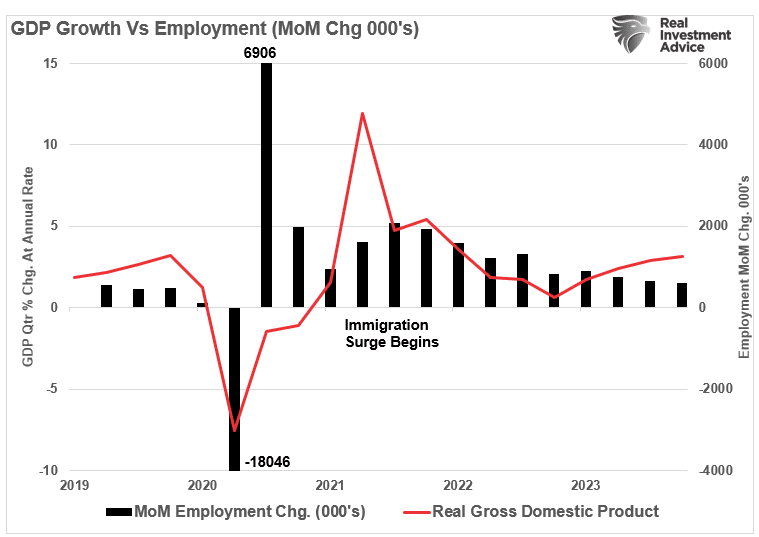
However, not all jobs are created equal.

Immigration’s Impact On Job Availability
Since 1980, the U.S. economy has shifted from a manufacturing-based economy to a service-oriented one. The reason is that the “cost of labor” in the U.S. to manufacture goods is too high. Domestic workers want high wages, benefits, paid vacations, personal time off, etc. On top of that are the numerous regulations on businesses from OSHA to Sarbanes-Oxley, FDA, EPA, and many others. All those additional costs are a factor in producing goods or services. Therefore, corporations must offshore production to countries with lower labor costs and higher production rates to manufacture goods competitively.
In other words, for U.S. consumers to “afford” the latest flat-screen television, iPhone, or computer, manufacturers must “export” inflation (the cost of labor and production) to import “deflation” (cheaper goods.) There is no better example of this than a previous interview with Greg Hays of Carrier Industries. Following the 2016 election, President Trump pushed for reshoring U.S. manufacturing. Carrier Industries was one of the first to respond. Mr. Hays discussed the reasoning for moving a plant from Mexico to Indiana.
“So what’s good about Mexico? We have a very talented workforce in Mexico. Wages are obviously significantly lower. About 80% lower on average. But absenteeism runs about 1%. Turnover runs about 2%. Very, very dedicated workforce. Which is much higher versus America. And I think that’s just part of these — the jobs, again, are not jobs on an assembly line that [Americans] really find all that attractive over the long term.“
The need to lower costs by finding cheaper and plentiful sources of labor continues. While employment continues to increase, the bulk of the jobs created are in areas with lower wages and skill requirements.

As noted by CNBC:
“The continued rebound of these jobs, along with strong months for sectors like construction, could be a sign that immigration is helping the labor market grow without putting too much upward pressure on wages.”
This is a crucial point. If there is strong employment growth, wages should increase commensurately as the demand for labor increases. However, that isn’t happening, as the cost of labor is suppressed by hiring workers willing to work for less compensation. In other words, the increase in illegal immigrants is lowering the “average” wage for Americans.
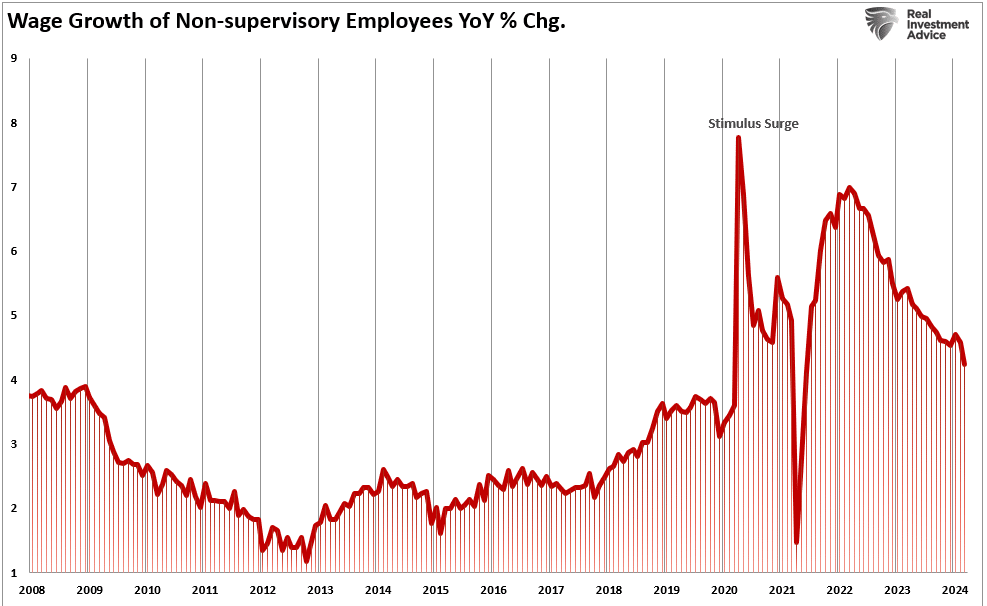
Nonetheless, in the last year, 50% of the labor force growth came from net immigration. The U.S. added 5.2 million jobs last year, which boosted economic growth without sparking inflationary pressures.
While immigration has positively impacted economic growth and disinflation, this story has a dark side.

The Profit Motive
In a previous article, I discussed an interview by Fed Chair Jerome Powell discussing immigration during a 60-Minutes Interview. To wit:
“SCOTT PELLEY: Why was immigration important?
FED CHAIR POWELL: Because, you know, immigrants come in, and they tend to work at a rate that is at or above that for non-immigrants. Immigrants who come to the country tend to be in the workforce at a slightly higher level than native Americans. But that’s primarily because of the age difference. They tend to skew younger.“
You should read that comment again carefully. As noted by Greg Hayes, immigrants tend to work harder and for less compensation than non-immigrants. That suppression of wages and increased productivity, which reduces the amount of required labor, boosts corporate profitability.
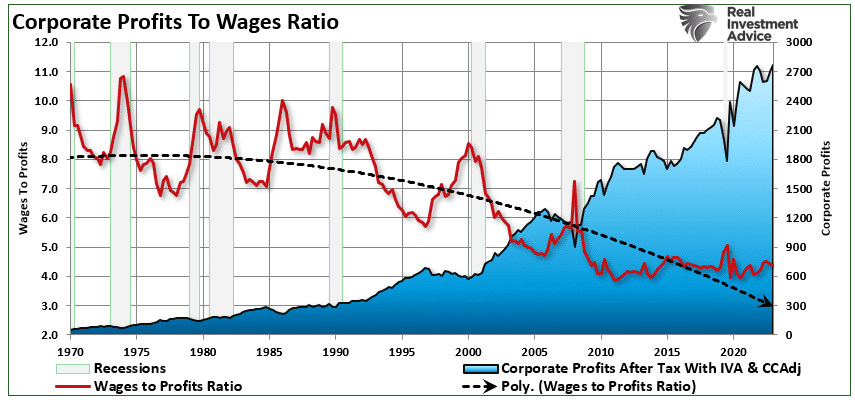
The move to hire cheaper labor should be unsurprising. Following the pandemic-related shutdown, corporations faced multiple threats to profitability from supply constraints, a shift to increased services, and a lack of labor. At the same time, mass immigration (both legal and illegal) provided a workforce willing to fill lower-wage paying jobs and work regardless of the shutdown. Since 2019, the cumulative employment change has favored foreign-born workers, who have gained almost 2.5 million jobs, while native-born workers have lost 1.3 million. Unsurprisingly, foreign-born workers also lost far fewer jobs during the pandemic shutdown.
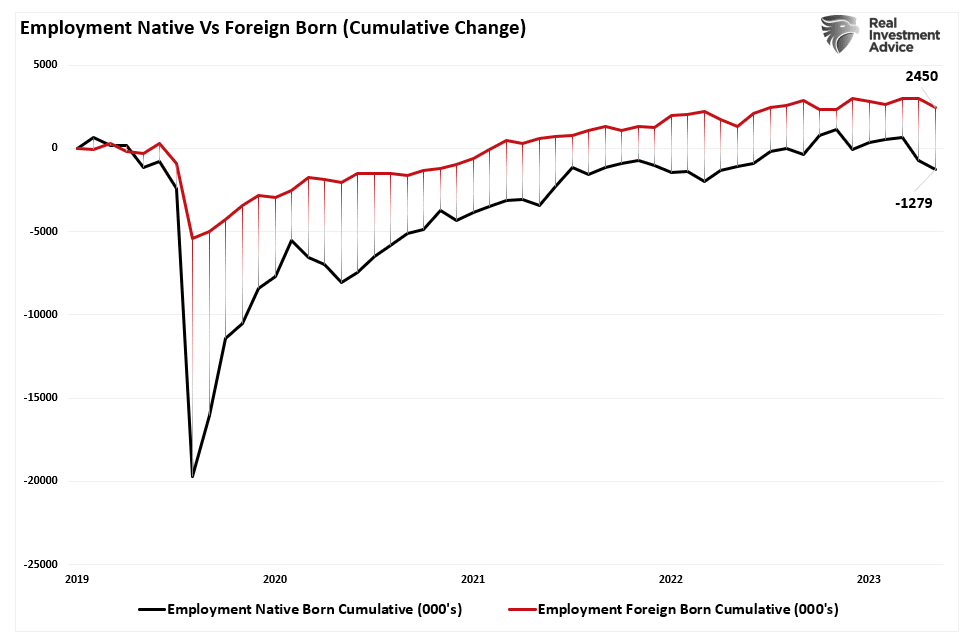
Given that the bulk of employment continues to be in lower-wage paying service jobs (i.e., restaurants, retail, leisure, and hospitality) such is why part-time jobs have dominated full-time in recent reports. Since last year, part-time jobs have risen by 1.8 million while full-time employment has declined by 1.35 million.
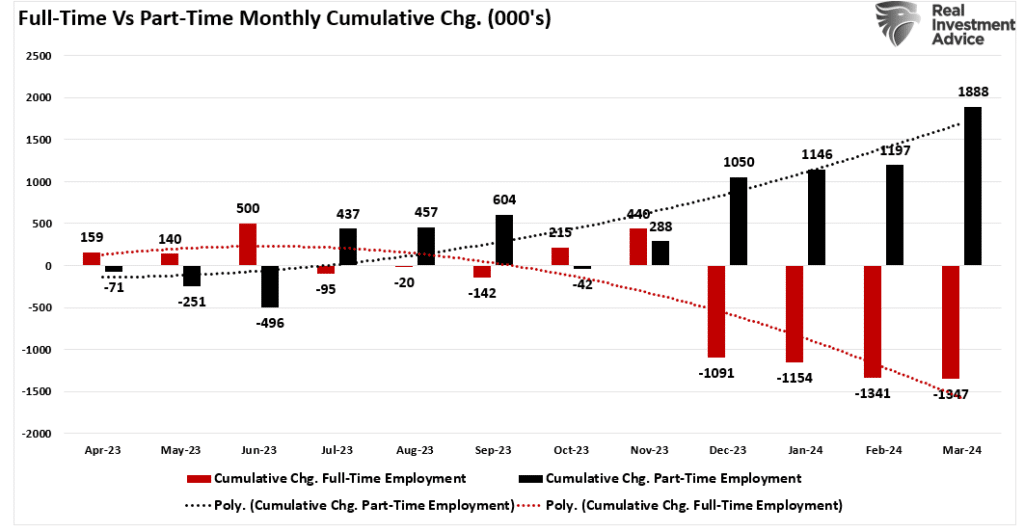
Not dismissing the implications of the shift to part-time employment is crucial.
Personal consumption, what you and I spend daily, drives nearly 70% of economic growth in the U.S. Therefore, Americans require full-time employment to consume at an economically sustainable rate. Full-time jobs provide higher wages, benefits, and health insurance to support a family, whereas part-time jobs do not.
Notably, given the surge in immigration into the U.S. over the last few years, the all-important ratio of full-time employees relative to the population has dropped sharply. As noted, given that full-time employment provides the resources for excess consumption, that ratio should increase for the economy to continue growing strongly.
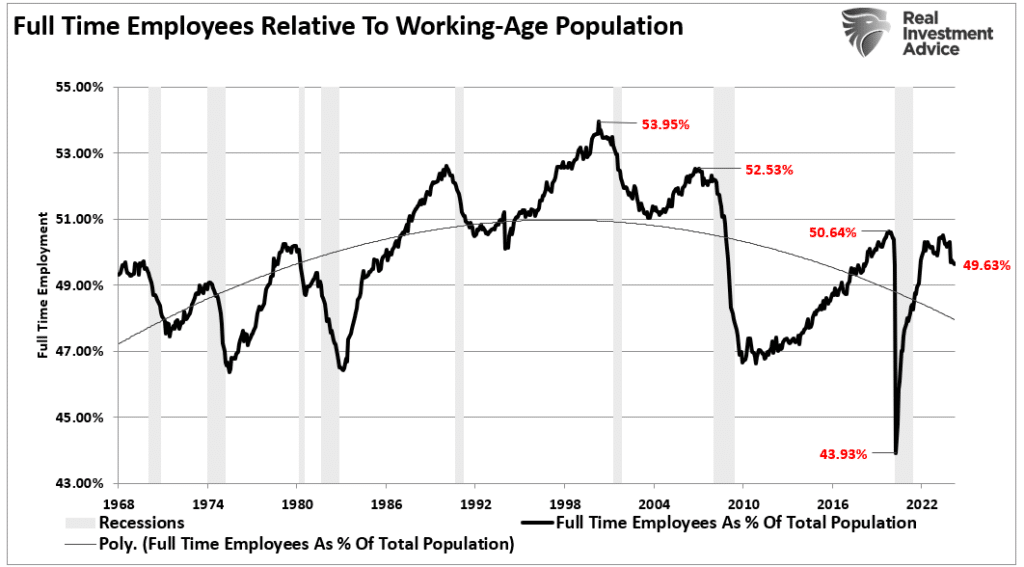
However, the reality is that the full-time employment rate is falling sharply. Historically, when the annual rate of change in full-time employment dropped below zero, the economy entered a recession.
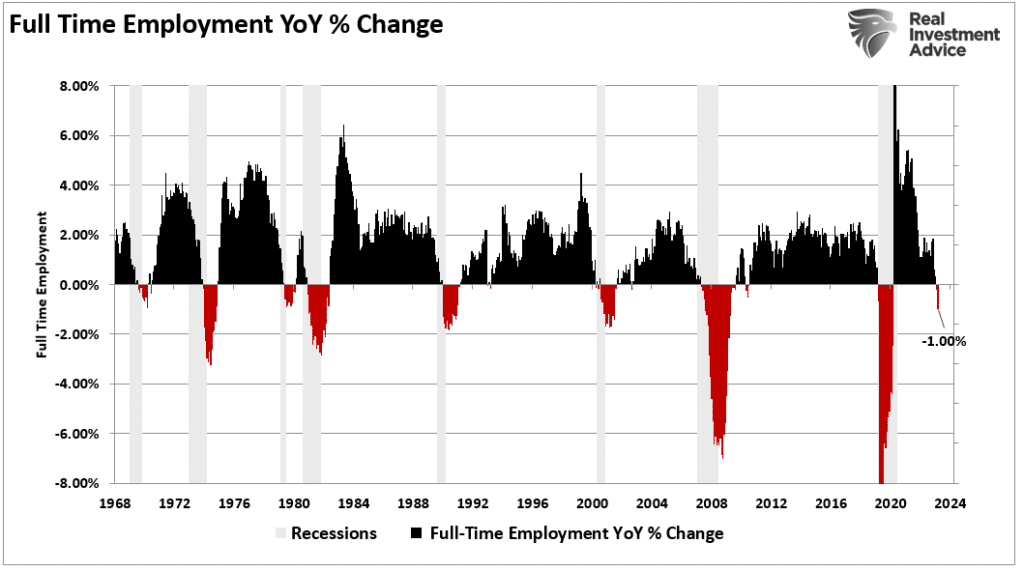
While there is much debate over immigration, most of the arguments do not differentiate between legal and illegal immigration. There are certainly arguments that can be made on both sides. However, what is less debatable is the impact that immigration is having on employment and wages. Of course, as native-born workers continue to demand higher wages, benefits, and other tax-funded support, those costs must be passed on by the companies creating those products and services. At the same time, consumers are demanding lower prices.
That imbalance between input costs and selling price drives companies to aggressively seek options to reduce the highest cost to any business – labor.
Such is why full-time employment has declined since 2000 despite the surge in the Internet economy, robotics, and artificial intelligence. It is also why wage growth fails to grow fast enough to sustain the cost of living for the average American. These technological developments increased employee productivity, reducing the need for additional labor.
Unfortunately, college graduates expecting high-paying jobs will likely continue to find it increasingly frustrating. Such is particularly the case as “Artificial Intelligence” gains traction and displaces “white collar” work, further squeezing the demand for “native-born” workers.
The post Immigration And Its Impact On Employment appeared first on RIA.
-
Site: Crisis Magazine

When President Joe Biden was asked by EWTN correspondent Owen Jensen what Easter means to him, he responded, “Time for forgiveness and people getting together, and a little bit of love and no phoniness. Be straight with people.” At first hearing, it might be shocking to hear a self-professed Catholic define Easter without mention of Christ and either His death or Resurrection—with neither…
-
Site: Crisis Magazine

On the matter of Christ’s alleged appearance among men, an event which we call the Incarnation of God, there is little room to maneuver once you’ve eliminated either madness or mendacity as an explanation for it. Leaving what? Only the bedrock certainty that it happened, which is to say, a miracle. And because that’s the one remaining option on the table, our acceptance of it becomes less a…
-
Site: Zero HedgeStuck On Failure At The WHOTyler Durden Fri, 04/12/2024 - 05:00
Authored by Kevin Roberts and Robert Redfield via The Epoch Times (emphasis ours),
Four years have passed since the onset of COVID-19 and the global mishandling of its spread. Now, the same governments and international organizations that lied about the last pandemic are negotiating a new pandemic agreement and amendments to the International Health Regulations (IHR) at the World Health Organization (WHO).
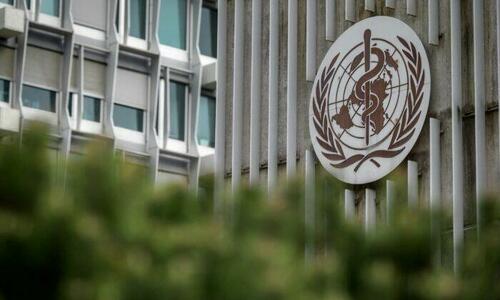 The sign of the World Health Organization (WHO) at its headquarters in Geneva on March 5, 2021. (Fabrice Coffrini/AFP via Getty Images)
The sign of the World Health Organization (WHO) at its headquarters in Geneva on March 5, 2021. (Fabrice Coffrini/AFP via Getty Images)
The main culprit hasn’t changed. Although the Chinese Communist Party (CCP) has never been held accountable for its complete refusal to adhere to previous IHR agreements or its ongoing obstruction of a thorough investigation into the virus’s origins, Beijing is now collaborating with the Biden administration on this new accord.
So naturally, the new agreement advances China’s interests. Successive drafts focus on everything, from sending taxpayer dollars overseas to weakening intellectual property rights and empowering the WHO over the national sovereignty of the United States. Yes, that’s the same WHO that failed to insert a team of global experts in the first few weeks of the COVID-19 outbreak in China (as required by IHR), instead capitulating to the CCP and allowing it to define the international response.
The latest version of the agreement even mandates that parties provide financial and technical assistance to developing countries. Of course, the United States has a long, robust history of providing such assistance—President George W. Bush’s President’s Emergency Plan for AIDS Relief (PEPFAR) is one good example—but such assistance has always been voluntary, not obligatory.
Unsurprisingly, China stands to benefit from these provisions intended to help “poor” countries. Despite having the second-largest economy in the world, the United Nations considers China to be a “developing country.” That’s right. The country that started the COVID-19 pandemic will not only suffer zero consequences for its actions but, should the United States sign this agreement, stand to benefit from mandatory transfers of funds from U.S. taxpayers.
China would also benefit from other provisions in the agreement that push governments to promote “sustainable and geographically diversified production” of pandemic-related products (like vaccines), invest in developing country capacity and access to proprietary research, use the “flexibilities” of the Agreement on Trade-Related Aspects of Intellectual Property Rights to override patents, and encourage rights holders to forego or reduce royalties and consider time-bound waivers of intellectual property rights.
China, notorious for its theft of intellectual property, would be sure to exploit this privilege.
All this would severely curtail future investment in health research—exactly the opposite incentive that should be applied if we are to be prepared for a future pandemic. And to make matters worse, the agreement almost entirely ignores addressing the countless shortcomings of current international processes in responding to pandemics, such as obligating governments to grant immediate access to international health expert teams to assess the threat of suspected outbreaks and to provide full and timely disclosure of genomic data.
Of course, overseeing sustainable and geographically diversified production, massive transfers, and distribution of up to 20 percent of diagnostics, therapeutics, or vaccines during a pandemic comes with a hefty price tag. The exact amount is not specified, but it is sure to include several commas.
In addition, the agreement would take a sledgehammer to American First Amendment free speech rights. The willingness of governments to use the pandemic to clamp down on unpopular ideas and opinions to “protect” public health and safety has proven durable. And this new agreement instructs governments to “cooperate, in accordance with national law, in preventing misinformation and disinformation.” China and Russia need no encouragement to censor speech. However, such language in an international agreement will encourage those in free countries who similarly wish to suppress unpopular opinions under the guise of countering misinformation and disinformation.
Indeed, the WHO itself seems offended by criticism. Earlier this year, Director-General Tedros Adhanom Ghebreyesus said that negotiations were occurring in a very difficult environment, facing a “torrent of fake news, lies, and conspiracy theories.” Ironically, this argument was the same one used against conservatives who subscribed to the increasingly credible lab leak theory.
In short, the new pandemic agreement should alarm all Americans. It is far more focused on redistributing income, transferring technology, and weakening intellectual property than on preventing, detecting, and responding to pandemics in the first place. It failed to address the elephant in the room—the total lack of enforcement in the IHR—and as written, it is nothing short of a power grab by the CCP-controlled WHO.
Our government must wholly reject it.
Views expressed in this article are opinions of the author and do not necessarily reflect the views of The Epoch Times or ZeroHedge.
-
Site: Fr. Z's BlogAs the world turns, one expected the Roman sun to rise at 06:32. It did. One expects it to set at 19:50. The Ave Maria Bell – 20:00. A note about the Ave Maria not being rung. I was working in … Read More →
-
Site: AsiaNews.itThe Armenian National Assembly held an extraordinary closed-door session, requested by opposition parties, to discuss border demarcation procedures in the disputed territories. Baku now insists on the 'restitution' of eight villages in the Tavowš region, while Yerevan claims that Azerbaijan has occupied 'all or part' of 31 of its localities.
-
Site: Zero HedgeGerman Defense Chief Compares Putin To HitlerTyler Durden Fri, 04/12/2024 - 04:15
Amid the recent days of stepped-up major Russian attacks on Ukraine's energy infrastructure, which the Kremlin on Thursday said is necessary in response to Ukrainian forces' own cross-border attacks on Russian oil refineries, the rhetoric out of Europe is becoming unhinged.
In but the latest example of this, German Defense Minister Boris Pistorius has compared Putin and his war in Ukraine to Nazi leader Adolf Hitler’s annexation of Czechoslovak territory in 1938.
 Via The Moscow Times
Via The Moscow Times
Pistorius echoed the assumption that Putin is waging an expansionist war and seeks to take more territory even beyond Ukraine, which remains unfounded and with zero evidence. Still, the defense chief urged Europe to prepare for large-scale Russian attack.
"Putin will not stop once the war against Ukraine is over," Pistorius said late Wednesday. Somewhat ironically, the provocative comments were issued at an event unveiling a new biography of Britain’s wartime leader Winston Churchill.
"He has also said that clearly," Pistorius continued. "Just as clearly as Hitler, who also always said that he would not stop."
"We have to put this country back in a position where it can defend itself," Pistorius said at the book event, as cited in Bloomberg. "We have to decide now whether we want to prepare for a genuine threat from Putin to materialize or whether we want to make it easy for him."
In February, Pistorius announced that Germany might seek to increase defense spending by as much 3.5% of economic output, though he also conceded that finding the funds would be tough.
NATO officials and connected think tanks have long assumed that Putin seeks to erect a new Russian 'empire' - given that in a number of speeches he's made positive references to Czar Peter the Great while speaking of "returning historically Russian lands."
But so far at least, there have been no actions of the Russian military directly threatening other states outside Ukraine. Recently Moldova has been a big concern of Western planners, with some reports claiming that the Kremlin is seeking to destabilize the small former Soviet republic which neighbors Ukraine and Romania.
Not so original: the whole 'Putler' trend and Hitler comparison has been a worn-out talking point of Western officials and media headlines going back years...
Putin is an illegitimate President who is afraid of real elections because he is afraid of his people.
— Rasa Juknevičienė (@RJukneviciene) April 10, 2024
To defeat him, bring victory to Ukraine, and freedom to the Russian people we need a bold coalition, similar to the one Allies created to defeat Hitler. @EPPGroup pic.twitter.com/Mg9d8zEkhXIn light of this latest "Putin is Hitler!" commentary out of Germany's defense minister, the below essay entitled Don’t Depict Putin, Kim, Assad And Others As Cartoon Villains by Mila Ghorayeb at The Maple is worth revisiting...
* * *
Despite knowing better, people’s conception of a government or even an entire country often rests on the image of its leader. People thinking of the Canadian government, for example, now fixate on Prime Minister Justin Trudeau. Americans fixate on leaders as well, often using terms like “Trump’s America” to tie the climate of social relations to their president. The head of state becomes the state itself.
But it goes even further with countries that the governments of the United States and Canada are unfriendly with. In these cases, mainstream media, pop culture and politicians speak of their leaders not only like they are the country, but as though they’re cartoon villains.
Former Libyan leader Muammar Gaddafi, famously called the “mad dog of the Middle East” by then U.S. President Ronald Reagan, had a documentary released about him post-mortem by the same name. Syrian President Bashar al-Assad is a “butcher” gone wild who supposedly unleashed chemical weapons on an area his government had nearly retaken just because he’s full of bloodlust. Magazines are riddled with covers depicting leaders, such as Russian President Vladimir Putin, as people that simply want to watch the world burn.
As a result, those involved in political discourse lose sight of basic international relations analysis. These leaders aren’t treated as rational actors that, in turn with other members of their government, act based on strategy. They are portrayed as being motivated merely by destruction.
Part of the reason for this is that some think “rational” has a positive value judgment attached to it. That is, if we acknowledge behaviour as motivated by a strategic rationale, we’re excusing it. But it also fits into a long line of colonial tropes, reminiscent of standards of civilization posited by European colonialists: the Global South is chaotic and uncivilized, giving Europeans entitlement to colonize these areas for their own good.
Today, the media portrays the good hegemons as democratic actors that solve their problems with level-headed strategy. Their enemies, meanwhile, are portrayed as erratic, hostile and rogue figures that will unexpectedly unleash violence simply because they can. As such, they can be portrayed as animals that need to be “tamed” or put down.
None of this is to say that these leaders are good. You’d be hard-pressed to find politicians that have not (albeit in varying degrees) done gravely immoral things. But we should care about our ability to point out that these leaders aren’t just acting to cause chaos, because politics and journalism should be concerned with the truth. We need to confront things as they really are.
Unfortunately, many conversations about foreign policy don’t discuss anything real at all, instead becoming theatrical gestures of moral grandstanding: There’s a villain that needs to be slain in order to fix a country’s problems, and that’s that. One of the reasons for this is to conceal who are really the victims of war and sanctions. Few Canadians would enthusiastically support sanctions against Iran or Syria, for example, if they knew they’d deeply deprive ordinary citizens of basic needs. As a result, sanctions are portrayed as targeting someone cartoonishly evil enough that the visceral response is to want to put them down with whatever method the state department insists will work.
For example, a Gallant Foundation study, reported on by the Yale Review of International Studies (YRIS) in 2018, found that U.S. print media compared Iraqi President Saddam Hussein to Adolf Hitler at least 1,035 times between August 1990 and February 1991, the period leading up to the Gulf War and through to its end. YRIS notes that the media narrative portrayed then-U.S. President George Bush as a brave hero confronting a “monster,” “beast” and “madman,” garnering American support for their government to attempt to remove Hussein from power.
North Korea is another case where cartoonishness is not only frequent, but the standard of reporting. Major outlets make baseless, often contradictory, claims, such as that all students in the country are required to get the same haircut as Kim Jong Un, or that no one is allowed to. These claims inevitably get debunked, yet leave the lasting impression that Kim is keeping an entire population subjugated not for any rational political motive, but to satiate absurd and borderline insane whims.
Of course, this kind of reporting is intended to do more than just entertain. If Kim is an unhinged monster that can’t be reasoned with, approaching North Korea with the utmost amount of aggression becomes justified. It makes Kim seem like a ticking time bomb that needs to be urgently confronted rather than diplomatically addressed. These efforts have worked, as an alarming amount of Americans, for instance, support a nuclear strike that would kill a large chunk of North Korean civilians.
This narrative has also created widespread worry about Kim having access to nuclear weapons, with American leaders and analysts publishing doom fantasies of an impending nuclear war. Some of this analysis will admit that Kim isn’t an irrational participant, but then still rests on a conception of him as a man with an unsatiated God-complex ruling over brainwashed individuals.
However, North Korea in recent history watched as Libya gave up its nuclear program only to have its government be overthrown shortly after, with Gaddafi being brutally sodomized and then murdered. North Korea saw and learned from this. As such, their nuclear program is a deterrent action by a rational state. This doesn’t make it a good government, but just means it’s capable of understanding state relations and making judgement calls for survival.
Further, mainstream media, pop culture and politicians need to stop oversimplifying the relationship between leaders our governments dislike and the citizens of their countries. The Communist Party of China, for instance, enjoys relatively high levels of support. Instead of careful reflection about what kind of policies make the party popular, along with other informative political metrics, it’s common to simply dismiss the Chinese population’s support for their government as a product of mass brainwashing. It’s hard for the media and onlookers to admit that the governments they demonize can simply enjoy popular support in a way that isn’t the result of a conspiracy.
Syria is another such case, where popular support for its oft-demonized leader is swept under the rug. To attempt to understand this support is met with accusations of apologism for Assad’s government. But there are factors relevant to Assad’s level of support that don’t revolve around his personality: the prevalence of terrorism, the potential ‘rally around the flag’ effect he may enjoy in the context of a war or the lack of a multi-sect opposition.
Admitting there are complex relationships between leaders and their population helps us ensure that we’re talking about something real in our political discourse.
I bring this up not because we need to praise or rehabilitate the personalities of world leaders. The intent is, rather, to point out that we place far too much emphasis on their personalities to begin with rather than the incentive structures that they, or their supporters, may be responding to. The solution is to instead strategically approach these incentive structures.
To be sure, the personalities of these individuals will play a role in their interactions with other leaders, but to make them the centrepiece is to obscure the conversation. We need to be able to talk about state behaviour and interactions without resorting to caricature, speculation and outright falsehoods.
To try and demystify what’s happening and wade through media sensationalism is not to exalt the media’s, or government’s, target. Rather, it’s an attempt to see things as they really are so that we can think for ourselves and come to organic conclusions.
-
Site: Zero Hedge'Automated Assassination': Israel Lets AI Decide Who Dies In GazaTyler Durden Fri, 04/12/2024 - 03:30
Authored by Will Porter via The Libertarian Institute,
The Israeli military has employed yet another AI-based system to select bombing targets in the Gaza Strip, an investigation by +972 Magazine has revealed. The new system has generated sweeping kill lists condemning tens of thousands of Palestinians, part of the IDF’s growing dependence on AI to plan lethal strikes.
Citing six Israeli intelligence officers, the Tel Aviv-based magazine said the previously undisclosed AI system, dubbed ‘Lavender,’ has played a “central role in the unprecedented bombing” of Gaza since last October, with the military effectively treating its output “as if it were a human decision.”
“Formally, the Lavender system is designed to mark all suspected operatives in the military wings of Hamas and Palestinian Islamic Jihad (PIJ), including low-ranking ones, as potential bombing targets,” the outlet reported, adding that “during the first weeks of the war, the army almost completely relied on Lavender, which clocked as many as 37,000 Palestinians as suspected militants—and their homes—for possible air strikes.”
However, while thousands have been killed in the resulting air raids, the majority were “women and children or people who were not involved in the fighting,” the officers told the magazine, noting that Israeli field commanders often rely on the AI system without consulting more substantial intelligence.
“Human personnel often served only as a ‘rubber stamp’ for the machine’s decisions,” one source said, adding that many commanders spend a mere “20 seconds” reviewing targets before approving strikes—“just to make sure the Lavender-marked target is male.”
Human input has been relegated to such a minor role in the decision-making process that Lavender’s conclusions are often treated as “an order” by Israeli troops, “with no requirement to independently check why the machine made that choice.”
Such decisions are made despite well-known system errors which result in misidentified targets in at least 10% of cases. Nonetheless, the AI has “systematically” selected the homes of suspected militants for strikes, with IDF bombings frequently carried out late at night, when entire families are more likely to be present.
In targeting lower-level Hamas fighters in the early stages of the war, the military largely resorted to the use of unguided ‘dumb bombs,’ concluding it was permissible to “kill up to 15 or 20 civilians” in such operations, the intelligence sources added. Senior militants, meanwhile, could warrant the deaths of “more than 100 civilians” in some cases.
“You don’t want to waste expensive bombs on unimportant people,” one officer said.
Automated Assassination
Lavender is far from the first AI program used to direct operations for Israel’s military. Yet another system unveiled by +972 mag, known as ‘Where’s Daddy?’, has also been used “specifically to track the targeted individuals and carry out bombings when they had entered their family’s residences.”
An unnamed intelligence officer told the outlet that homes are considered a “first option” for targeting, observing that the IDF is “not interested in killing [Hamas] operatives only when they [are] in a military building or engaged in a military activity.”
As of April, Israeli bombings have damaged or destroyed a staggering 62% of all housing units in Gaza—or nearly 300,000 homes—leaving more than 1 million people internally displaced, according to United Nations estimates. The territory’s housing sector has borne the brunt of the Israeli onslaught, representing well over two-thirds of the destruction in Gaza to date.
Earlier reporting has shed further light on Israel’s AI-driven “mass assassination factory,” with another program, ‘the Gospel,’ used to automatically generate massive target lists at a rate vastly exceeding previous methods. Under the guidance of that tool, Israeli forces have increasingly struck what they call “power targets,” including high-rise residential structures and public buildings. Such attacks are reportedly part of an effort to exert “civil pressure” on Palestinian society—a tactic clearly prohibited under international law as a form of collective punishment.
What War by A.I. Actually Looks Like - The Israel Defense Forces’ offensive in Gaza is an ominous hint of the military future Via @nytimes: https://t.co/mHVTuP2zbu
— Olav Mitchell Underdal (@omunderdal) April 10, 2024The IDF has long relied on extensive “target banks” in planning operations in Gaza and the West Bank, gathering a long list of suspected militant command posts and installations. In recent years, however, those lists have swelled to include thousands of potential targets as the military outsources decision-making to automated systems.
Adding to the litany of AI programs used to deliver death in Gaza and beyond, Israel’s ‘Fire Factory’ system helps to automatically calculate munitions payloads and assign targets to particular aircraft or drones once they are selected. “What used to take hours now takes minutes, with a few more minutes for human review,” an IDF colonel said of the system in comments to Bloomberg.
Artificial intelligence and AI-powered facial recognition tech have similarly taken a greater role in policing the border between the occupied territories and Israel proper—as well as West Bank checkpoints—with the IDF deploying a litany of new systems to identify, surveil and arrest Palestinians in recent years.
-
Site: Zero HedgeSoutheast Asia's Preferred Ally Switches In Favor Of ChinaTyler Durden Fri, 04/12/2024 - 02:45
If Southeast Asian countries had to choose a strategic partner, slightly more would now prefer to align with China than the United States.
Statista's Katharina Buchholz reports that a poll conducted by the Institute of Southeast Asian Studies found that 50.5 percent of respondents in the ten ASEAN member countries would choose the Asian power in 2024, while 49.5 percent would pick the United States.
This has changed from 38.9 percent and 61.1 percent, respectively, just one year ago.
You will find more infographics at Statista
The change is largely due to respondents from Laos, Indonesia and Malaysia favoring China more strongly at an increase of between 20 to 30 percentage points each since 2023.
In Cambodia, support increased by around 18 percentage points, but remained below 50 percent overall.
The picture in similar in Thailand and Myanmar at increases of around 10 percentage points each and with support for China in Thailand reaching 52 percent.
Countries that would still strongly prefer to partner with the United States are the Philippines (83.3 percent in favor of the U.S.), Vietnam (79 percent) and Singapore (61.5 percent).
In all three countries, support for the U.S. was relatively stable compared to 2023.
-
Site: Mises InstituteFree markets in agriculture undermined communist governments' attempts to collectivize farming. You can strike a blow against state control by simply gardening.
-
Site: Zero HedgeHow Turkish Sanctions Against Israel Will Impact Bilateral TradeTyler Durden Fri, 04/12/2024 - 02:00
Turkey’s decision to halt the export of 54 products to Israel in response to its war on Gaza isn’t likely to have far-reaching results, since both countries' economies are complementary in nature rather than central to each other.
The Turkish trade ministry announced earlier this week that Ankara would continue to implement the restrictions as long as Israel denies uninterrupted flow of humanitarian aid to Gaza Strip, citing UN Security Council decisions and an International Court of Justice (ICJ) preliminary judgment against Israel’s conduct in the coastal enclave. The export restrictions encompass items such as aluminium wire, steel, cement, construction materials, granite, chemicals, pesticides, engine oils, jet fuel and bricks.
 Israel's Haifa commercial shipping port in the Mediterranean Sea, NurPhoto
Israel's Haifa commercial shipping port in the Mediterranean Sea, NurPhoto
Before the war, Turkish-Israeli ties had been steadier than they had been for years. After years of tensions over Palestine, the two normalized relations in 2022. Yet, while Turkey and Israel quarreled over the past decade, and even stopped cooperating with each other, trade had never been interrupted. In fact, it flourished over time.
The Turkish public has been outraged at Israel’s actions in Gaza, where reportedly more than 33,000 Palestinians have been killed in six months. Lists of ships carrying goods to Israel circulated on social media as Israel's onslaught grew. People also highlighted companies close to the Turkish government that continued commercial relations with Israel during the war.
Even though there is no evidence to back claims that Turkey sold weapons to Israel, the controversy was stoked by a small quantity of hunting gear or hunting equipment parts being found among the exports. They were broadly classified by the Turkish Statistical Institute (TUIK) as “weaponry”.
In response to this domestic pressure and serious setbacks for the ruling Justice and Development Party (AKP) in local elections last month, the government decided to act against Israel.
Ties have been cut on the Israeli side, too. In October, several Israeli supermarket chains halted imports from Turkey in response to Ankara’s critical stance on the Gaza war. Israeli food company Strauss in December changed the packaging for one of its most well-known products, Elite Turkish coffee, adding an Israeli flag and patriotic slogans.
An important market
But is the trade between the two countries vital? Many say no, but Israel is nonetheless an important export market for Ankara. Turkey’s exports to Israel were worth $5.4bn in 2023, or 2.1 percent of its total exports, according to official data.
Although bilateral trade has dropped by 33 percent since the October 7 Hamas-led attack, it has nonetheless continued and exports to Israel have increased each month in 2024 so far. Both countries have had a free trade deal in place since 1996 and there have been no tariffs on certain products since 2000, which has enabled major increases in bilateral trade, largely favouring Turkey.
From 2009 to 2023, trade between the two countries nearly tripled. By the end of that period, Turkey had become the fifth-largest supplier of imported goods to Israel, while Israel ranked as Turkey's tenth-largest export market, based on data from the Central Bureau of Statistics.
Turkey exported steel, automotive industry products, chemicals, ready-made clothing and apparel, electricity and electronics, cement, glass, ceramics and soil products, furniture, paper, and forestry to Israel, according to a report published by the Turkey Exporters Assembly covering the period between 2011 and 2020.
“The economies are complementary but not intertwined,” Gallia Lindenstrauss, a senior research fellow at the Institute for National Security Studies (INSS), told Middle East Eye. “Turkey can find also substitutes to what it imports from Israel, and anyhow, of the bilateral trade, three-quarters are Turkish exports to Israel and only one-quarter is Israeli exports to Turkey.”
Trade with Israel has traditionally been highly advantageous for Turkey, which enjoyed a trade surplus of $3.9bn last year. Israel serves as a significant market for Turkish steel, purchasing 726,000 tonnes last year. This figure constitutes over 20 percent of Turkey's total steel exports. The ban is expected to significantly affect these exports.
In terms of dependence on imports, Israel heavily relies on Turkish cement, with imports from Turkey making up 29 percent of Israel's total cement imports last year. Additionally, Turkish imports represent about 11 percent of Israel's total plastic and rubber products, and around 10 percent in textiles.
Sources familiar with the construction industry told Israeli news outlet Mako that the new restrictions were expected to increase the prices of apartments and rent in the country if they are implemented. “In terms of long-term repercussions, the fact the Turkey halts construction materials when these are needed to repair damaged houses in the south and north of Israel because of rockets and other damage will likely taint relations also in the future,” Lindenstrauss said.
“Also, while anyhow there were question marks regarding a possible gas pipeline between Israel and Turkey, these export restrictions in a time of war will be a big warning sign not to proceed with the pipeline idea.”
Impact on Palestine
Turkey’s decision to restrict exports to Israel likely has an impact on Palestine as well. “Israel has complete control over the border crossings as Palestinian imports arrive at Haifa or Ashdod seaports, and the goods are then transported to Palestinian territories via trucks," Rashad Yousef, director of policies and planning at the Palestinian Ministry of National Economy, told Anadolu Agency.
Yousef added that Palestinian-Turkish trade volume in 2022 exceeded $900m, representing a 12 percent increase over 2021. He also said that the main Turkish exports to Palestine are iron, wood, vegetable oil, tobacco, food products and items from the plastic industries.
"If we exclude Israel, Turkiye is the largest source of goods and products in the Palestinian market," Yousef said. However, there are ways to continue to trade with Israel by rerouting trade through third countries, as the Ukraine war has proved following western sanctions on Russia.
Israeli importers are mulling bringing in Turkish goods via Slovenian ports Koper or Ljubljana, according to an Israeli report. “But still, the economic relations were what kept the relations going even in times of political crisis, so it is regrettable we have reached this point,” adds Lindenstrauss.
“And despite it having been a painful step, I don't see it in itself changing Israel's policy - the pressures from the White House are much more significant.”
-
Site: RadTrad ThomistHere is the Just Released Statement of the Fatima Center: Pinned by The Fatima Center3 hours ago@TheFatimaCenter
-
Site: The Unz ReviewPreviously: Brandon Pledges “Ironclad” Support for Israel Against Iran Right now, Bibi is fighting a “war.” It’s not an actual war, as there is no serious enemy that he is confronting. Basically, he is just slaughtering kids. Hamas does exist, of course, and they do shoot rockets and sometimes blow up tanks, but the IDF...
-
Site: The Unz ReviewNature might abhor a vacuum, but it apparently loves an analogy—at least of the genetic and behavioral kind. That is, no matter how much humans may wish to be above and separate from the workings of the rest of the animal kingdom, they are constantly acting in ways analogous to those creatures they so look...
-
Site: The Catholic Thing
 Grounded in the sources of divine Revelation, the diaconate holds a unique and irreplaceable role within the Church. Deacons are ordained to serve, embodying the Church’s sacramental life alongside its call to service. This vocation is a living bridge between the altar and the needy, between the Church’s worship and its mission to serve the marginalized. The absence of deacons in the synodal conversations is a gap that deprives the Church of the fullness of its identity.
Grounded in the sources of divine Revelation, the diaconate holds a unique and irreplaceable role within the Church. Deacons are ordained to serve, embodying the Church’s sacramental life alongside its call to service. This vocation is a living bridge between the altar and the needy, between the Church’s worship and its mission to serve the marginalized. The absence of deacons in the synodal conversations is a gap that deprives the Church of the fullness of its identity.
The post A voice unheard: The absence of deacons at the Synod appeared first on The Catholic Thing.
-
Site: The Catholic Thing
 In a Q&A about his new book, Fr. White says there are two central challenges to Christian belief prevalent in Western culture. The first is “indifferentism,” the idea that all religions and worldviews are equally arbitrary or implausible. The other is scientific naturalism, which holds that the laws of physics, chemistry, and biology are the best and virtually the only resource we have to explain reality, and there is no other answer to why human beings exist. Enjoy the view; you will be dead soon.
In a Q&A about his new book, Fr. White says there are two central challenges to Christian belief prevalent in Western culture. The first is “indifferentism,” the idea that all religions and worldviews are equally arbitrary or implausible. The other is scientific naturalism, which holds that the laws of physics, chemistry, and biology are the best and virtually the only resource we have to explain reality, and there is no other answer to why human beings exist. Enjoy the view; you will be dead soon.
The post The rational credibility of Christianity appeared first on The Catholic Thing.
-
Site: The Catholic Thing
First Old Man
He threw his crutched stick down: there came
Into his face the anger flame,
And he spoke viciously of one
Who thwarted him—his son’s son.
He turned his head away.—“I hate
Absurdity of language, prate
From growing fellows. We’d not stay
About the house the whole of a day
When we were young,
Keeping no job and giving tongue!
“Not us in troth! We would not come
For bit or sup, but stay from home
If we gave answers, or we’d creep
Back to the house, and in we’d peep
Just like a corncrake.
“My grandson and his comrades take
A piece of coal from you, from me
A log, or sod of turf, maybe;
And in some empty place they’ll light
A fire, and stay there all night,
A wisp of lads! Now understand
The blades of grass under my hand
Would be destroyed by company!
There’s no good company: we go
With what is lowest to the low!
He stays up late, and how can he
Rise early? Sure he lags in bed,
And she is worn to a thread
With calling him—his grandmother.
She’s an old woman, and she must make
Stir when the birds are half awake
In dread he’d lose this job like the other!”Second Old Man
“They brought yon fellow over here,
And set him up for an overseer:
Though men from work are turned away
That thick-necked fellow draws full pay—
Three pounds a week…. They let burn down
The timber yard behind the town
Where work was good; though firemen stand
In boots and brasses big and grand
The crow of a cock away from the place.
And with the yard they let burn too
The clock in the tower, the clock I knew
As well as I know the look in my face.”Third Old Man
“The fellow you spoke of has broken his bounds—
He came to skulk inside of these grounds:
Behind the bushes he lay down
And stretched full hours in the sun.
He rises now, and like a crane
He looks abroad. He’s off again:
Three pounds a week, and still he owes
Money in every street he goes,
Hundreds of pounds where we’d not get
The second shilling of a debt.”First Old Man
“Old age has every impediment
Vexation and discontent;
The rich have more than we: for bit
The cut of bread, and over it
The scrape of hog’s lard, and for sup
Warm water in a cup.
But different sorts of feeding breaks
The body more than fasting does
With pains and aches.
“I’m not too badly off, for I
Have pipe and tobacco, a place to lie,
A nook to myself; but from my hand
Is taken the strength to back command—
I’m broken, and there’s gone from me
The privilege of authority.”
I heard them speak—
The old men heavy on the sod,
Letting their angers come
Between them and the thought of God.The post Old Men Complaining appeared first on The Catholic Thing.
-
Site: The Catholic Thing
 Former President Donald Trump said on Wednesday that he would not sign a national abortion ban if reelected in November. The Republican presidential candidate was at an event in Atlanta on Wednesday when a reporter asked him: “Would you sign a national abortion ban if Congress sent it to your desk?” “No,” Trump said in response.
Former President Donald Trump said on Wednesday that he would not sign a national abortion ban if reelected in November. The Republican presidential candidate was at an event in Atlanta on Wednesday when a reporter asked him: “Would you sign a national abortion ban if Congress sent it to your desk?” “No,” Trump said in response. The post Trump will not sign abortion ban if re-elected appeared first on The Catholic Thing.
-
Site: The Catholic Thing
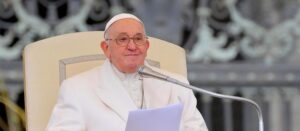 Without prior notice, Pope Francis has reversed something that his predecessor Benedict XVI had changed during his pontificate. The Pope now once again bears the historic title of “Patriarch of the West” (Patriarca dell’Occidente), as he last did in 2005. Benedict XVI had this title removed from the list of papal titles in the first year of his pontificate, causing irritation among the churches of the East.
Without prior notice, Pope Francis has reversed something that his predecessor Benedict XVI had changed during his pontificate. The Pope now once again bears the historic title of “Patriarch of the West” (Patriarca dell’Occidente), as he last did in 2005. Benedict XVI had this title removed from the list of papal titles in the first year of his pontificate, causing irritation among the churches of the East.
The post Pope proclaims himself ‘Patriarch of the West’ appeared first on The Catholic Thing.

